Gunfire at the Ft. Myers charitable event created a real-life running zombie herd, but the organizers’ security safeguards may have helped prevent further harm. Shootings have become a depressing fact of life here in the U.S. — and for those of you who spent a fair amount of time in New York and other large […]
Viewing: Blog Posts Tagged with: SDCC 14, Most Recent at Top [Help]
Results 1 - 25 of 100
Blog: PW -The Beat (Login to Add to MyJacketFlap)
JacketFlap tags: shootings, Helloween!, Top News, The Legal View, Top Comics, SDCC '14, ZombiCon, Comics, Sociology, Legal Matters, Conventions, Culture, Image, Breaking News, guns, Walking Dead, crowds, Add a tag
Blog: PW -The Beat (Login to Add to MyJacketFlap)
JacketFlap tags: Indie Comics, Top News, SDCC '14, Cartoonists, Marvel, Conventions, Dark Horse, Breaking News, Add a tag
The Best of Comix Book: When Marvel Went Underground
is in B&W/ and Full color, HardCover an exclusive Kitchen Sink Press imprint under Dark Horse ISBN:978-1-61655-258-9
Intro by Stan Lee
Forward by Denis Kitchen
Designed and Edited by John Lind
Pam Auditore
Tall, affable, plain spoken Wisconsinite, Denis Kitchen smiles wistfully, “I loved putting this collection together. It’s a nice anniversary.” Hardly the hippie, bomb throwing revolutionary Nixon might associate with with the words: “Undeground Comic Artist.”
In 1973 Denis Kitchen and Stan Lee pulled off what can only be considered, in hindsight, a coup. Bringing together the Marvel and Underground Comic Book Creators in almost unimaginable collaboration. Taking place during the turbulent spill over from the 1960s with the The Vietnam War winding down; Watergate; white flight from cities; social unrest and a New York City as grey and dilapidated as “Taxi Driver” depicts.
At the time, Stan Lee and his bullpen at Marvel were struggling to churn out Super Heroes, Westerns, Science Fiction, Fantasy, War Comics, Hot Rods, Romances and whatever would keep the company alive and paying their bills.
Reacting to and expressing the societal upheaval and the angst of the times, Underground Comics emerged first in Head Shops, then local Bookshops. Artists like Spain, Bill Griffith, R. Crumb, Trina Robbins were free to do what creators at DC and Marvel could not, express freely and personally what they saw going on in their own lives and the world around them without having to censor for profanity, nudity or subject matter. Expressing their own visions through writing and artwork.
It may seem quaint now, in the time of a Deviant Art Digital hyperspace, where one can upload and share with just about everyone anything conceivable, from Justin Beiber fan fiction to Banksy’s or Shepard Fairey’s latest and greatest. Yet, once, Underground Comic Art was not only ground breaking, but dangerous and could have serious consequences such as shutting down businesses, along with jail time and financial ruin.
Back then, the US Mail was your only delivery system or your car. Your tools–paper, pencil, ink, mimeographs, with Xerox Copiers expensive even for Marvel. Your only means of distribution were friends, Comic Shops, Head Shops, and some Bookshops. Marvel’s were mainly Newsstands, local groceries, local bookstores and candy shops. Getting kicked off of any one of those racks could mean never making a cent again.
Among those first to collect and publish his own Underground Comics was Denis Kitchen with his Mom’s HomeMade Comics in 1969. Issues of which Kitchen sent to publishers like Stan Lee and Harvey Kurtzman. Kitchen later went on to publish other Comic Book creators under Kitchen Sink Press. Such legal issues of censorship and community standards is why Mr. Kitchen is one of the Founder of the Comic Book Legal Defense Fund
By the ’50s and ’60s Marvel, DC, and Harvey Comics were squarely aiming at the growing demographic of Baby Boomers while laboring under a self imposed Comics Code to protect minors.
Which made the explosion of Underground Comics during the hey day of suburbia and the middle class all the more “subversive” and “scandalous” with its humor, nudity, crudity, and profanity, would feel so refreshing and right for the times.
Clearly not meant for the young teens or little kids the major Comic Book publishers were catering to. These comics dealt with political and social issues were generally called, “anti-establishment”, made for a slightly older, “hipper” crowd–late high school to college crowd. Many Underground Cartoonists would find their way into the glossy folds of “Mad magazine” and “National Lampoon“, but others like Mr. Kitchen and, others of his cadre like Art Speiglemen, were charting a more independent, less conventionally commercial path. Creating space for other self-published Independent Comics to flourish in the ‘80′s, like those of Charles Burns, Daniel Clowes, and the Hernandez Bros, then Terry Moore and Peter Bagge in the ‘90′s and so on into the future.
With ever a sharp eye on popular culture, Stan Lee, no doubt , was eager to capitalize on the Underground audience hoping to expand Marvel’s.
According to Kitchen, his collaboration with Lee, “Stems from a time when Underground Comics were florishing and suddenly we had what we called ‘the Crash of ’73.” A glut of material in Head Shops and local book stores and a Supreme Court ruling that threw obscenity laws into local jurisdictions. It was deadly to the Undergrounds, a lot of Head Shops and Bookshops were suddenly paranoid that they would be busted due to obscenity. I genuinely feared Kitchen Sink Press and all my cohorts would go under.”
Luckily, Denis had been corresponding with Lee. “We had this curious pen pal relationship. He offered me a job a couple of times. Of course, I was flattered but said, ‘No,’ until the Crash. He happened to call and I said, ‘Let’s talk.’ I flew to New York City and found he was amazingly receptive to an experimental magazine. One where we hoped to take the essence of the Underground and plug it into Marvel’s distribution system.
It took a lot of negotiating to find out how far Marvel could compromise. Stan ended up being amazingly receptive to using four letter words, and we even got away with full frontal nuditity, anything we wanted.”
But don’t think it was a collaboration without conflict.
“There were fights over copyrights and getting art back, too “But we wore him (Stan Lee) down, so by the Third issue he said, “Goddamit, you can have your rights back, you can have your art back.’ So all this stuff that they had never done before, I was able to persuade him to do.”
The end was nigh when word of this new magazine began reaching the ears of Stan’s regular bullpen of writers and artists “it turned into a Pandora’s Box for Stan. The regulars and freelancers were like, ‘How come you’re doing this stuff with these Hippies? And you’re not letting us? We’ve been with you longer?’ And it was hard for Stan to walk that back.”
Consequently, “After the third issue, Stan pulled the plug. I had a couple of issues in the can and I asked him if he’d let me print the rest under Kitchen Sink, and he agreed, which was amazingly generous. ”
“In retrospect it’s kind of astonishing. When I look back at it now, that it happened at all and the kind of latitude we had. Artists like S. Clay Wilson, Justin Green, Trina Robbins, Art Spieglman (including the first national appearence of “Maus”). You can go down the list, all the big guys in Underground Comics, except Crumb, were in it. And most Underground Comic fans today don’t even know it happened.”
“When we decided to collect it Stan, graciously agreed to the intro. He actually called it one of the greatest things he ever did,” Denis Kitchen beams.
 Denis Kitchen and Stan Lee signed a special insert in 250 special copies ot the The Best of Comix Book only available only from Things From Another World, Dark Horse’s online retail outlet.
Denis Kitchen and Stan Lee signed a special insert in 250 special copies ot the The Best of Comix Book only available only from Things From Another World, Dark Horse’s online retail outlet.
Blog: PW -The Beat (Login to Add to MyJacketFlap)
JacketFlap tags: Comics, Art, Top News, SDCC '14, By Its Cover, Add a tag
This will be the last By Its Cover for a few months, so I thought I’d do something special. Today we’re going to look at the Image Expo teaser images shown at SDCC 2014.
To be clear, these aren’t necessarily covers. In theory, they’re teaser images intended to get people interested in each series, though half of the teasers look like they just used the first issue’s cover art.
When Torsten Adair suggested the topic, I was initially hesitant. I made a conscious decision to focus on the best covers each week – partly in hopes of inspiring people to create more visually diverse covers – but these Image Expo images range from great to distinctly not-great. Though it’s possible for us to learn just as much (or more) from seeing people’s failures as their successes.
I guess what I’m trying to say is that I almost feel like the column you are about to read needs a warning. I was going easy on the covers before; we’re about to go critical.
Methodology: I purposely avoided reading the descriptions of each book until after I’d looked at the corresponding teaser image. I then showed the images to a couple of friends who also knew nothing about the books, to see if their impressions differed. What follows are the results.
I’ve decided to go through these in reverse order from how the books were announced, because I wanted to start off with an example of perfection. Sleek and stylish, this teaser doesn’t say much, but in a tantalizing way that makes me want to know more.
The way the syringe icon doubles as a pill is perfect. The texture inside the icon wasn’t really necessary, but it works regardless. Futura is one of those sturdy, timeless fonts that’s ridiculously overused, yet never gets old. And like any proper teaser, it tells me the month and year it’s coming out.
That said, based on my own experience, I’m betting there are a lot of non-designers out there who consider this image boring. But I’m not sure that can be helped.
Tooth & Clawl? Tooth &…Crawl? Crawl? Clawl?
It took me two minutes looking over this image before I realized it said “Tooth & Claw 1.” I can understand putting the “1″ in there so that the ampersand is centered (and it’s a great ampersand, by the way), but the number’s similarity to the lowercase “l” hurts the title’s readability. Plus, what do you do with Tooth & Claw 2 and beyond? Since all other numbers are wider than “1,” the ampersand will either no longer be centered, or the title is going to look cramped.
Also, the lowercase “l” looks weird with the upper serif coming off the wrong side like that.
But the title treatment isn’t the only problem. My friends and I all found this cover to be visually boring, and I couldn’t figure out why. I’m a fan of Busiek’s writing, so I want to like this. The image is well drawn and well composed. I dig symmetrical compositions. And it’s an image of a warthog doing magic! So why does it make me want to scroll away quickly to something more visually pleasant?
The problem is the colors. Instead of being used to create depth, they’re flattening the image out. The old staple of warm-and-cold contrast is being used for the background, but the gradient meets in the center as a dull gray. The blue orb sits in the cold area of the gradient, where there is the least contrast, and likewise all the brownish red elements sit in the warm area of the gradient.
The warthog, who should be the focus of the piece, is colored entirely in very desaturated colors that push the focus to the less gray background elements. Even the glowing light in the character’s hands is gray, instead of a vibrant white. The glowing objects around the character are separated from the light blue background with a strange warm gray glow that flattens them out, making it look like the character is sitting (well, floating) in front of a painted wall instead of summoning light. From a distance, the image balances out to dull gray and brown.
A better approach? Glowing objects are hard to convey against light backgrounds. A lightsaber doesn’t look as good in front of a white or pastel wall as it does behind dark colors. If the warthog was floating in front of a black background, everything lit only by the green objects emanating from the character’s hands, that would be one dramatic image.
(Yes, I realize Jordie Bellaire just won an Eisner for Best Coloring. Feel free to tell me I’m wrong.)
Whoa, look at that title logo. That’s crazy. I never would’ve attempted something so wild and chaotic, and that’s why I love it.
I also love the expressiveness of the painting, and the color palette is solid. I don’t quite get the light blue circle (sun? moon? something else?) that’s overlapping his face, but since they’ve already consciously broken all the rules with the rest of the composition, I feel like I should just go with it.
My first guess as to the story was “a western set in space?,” and the description pretty much confirmed it, so it’s a success there too. All it’s missing as far as teasers go is a date. It doesn’t count if you hid it in those seemingly random dots, guys.
The image of the kid behind the moon works really well when I’ve seen it cropped down on other sites, but otherwise the composition is a little awkward. I kind of want the kid’s eye line to be pointing to the title and credits, rather than just under them and over to whatever is to the right of the image.
There are a few different approaches that I think might work a little better. I don’t think the typeface used for the title works very well spaced out like that. A taller typeface would probably work better, like the one used for the creator’s names. But there’s so much space for a title at the top of the image, you could go even taller.
Or, the image could be cropped in so that the moon is centered horizontally, and the title and creator names could be centered within the moon. Or, the image could be cropped in so that part of the left side of the moon is cut off (the kid being places on the left side of the rule of thirds), and the title and creator names placed small in the upper right corner (not overlapping the moon).
I’m not sure if I’m making sense, so here are examples.
Am I the only one who hadn’t heard of the constellation the Southern Cross? Maybe that just shows how ignorant I am of astronomy, I don’t know. I initially thought the dots in the “O” were an attempt at making it look like a moon, until I saw the symbol in the Image logo, and still didn’t realize it was a constellation. Make fun of me if you want.
So my first thought looking at this teaser is that the story takes place in the south, and is about some sort of angel or winged main character who is transporting a ghostly corpse a la Hellboy. After I was informed about the constellation, I still figured it was the same story, only set in the southern hemisphere.
The story description tells me I couldn’t be more wrong. It doesn’t even take place on earth! It’s about a tanker flight heading to Titan called the Southern Cross, and what I took to be wings are probably the frame around a window. The corpse might be hitching a ride, as I thought before, or it might be trying to strangle the character.
It’s well drawn, but isn’t quite getting across the concept. It’s described as “The Shining on a haunted spaceship,” but I got neither a spaceship nor The Shining from this. The look of internal peace and calmness on the character’s face does not convey a horror vibe.
In terms of type, it’s kind of distracting to me how “SOUTHERN” is in very clean Futura, while “CROSS” is in Futura that’s been roughed up to look hand-drawn. They should either both look hand-drawn, or both look clean. Or maybe the hand-drawn word should look more hand-written (instead of a roughed up geometric font), but it might be tougher to get that to work. I also kind of want to see the Image logo moved up below the logo and resized to the same height as the “01,” to balance out the top half of the image.
A collage like this could’ve completely fallen apart, but I think it works. I immediately get that this is two locations combined into a single image, rather than two people finding a cave filled with ships flying away from a tiny planet. I think the ships flying overhead behind them helps a great deal in terms of that.
The only thing I’m not sure of is the stream. Is it lava? It looks like they’re standing in it, so I assume not. Is it just water colored red because artistic license? It’s the one element that isn’t really working for me, because I don’t really like how it flows behind the ships.
It’s not an elegant cover, but it does a perfect job of getting across the concept, assuming that concept is “Planet Of The Apes meets The Wild Angels.”
A critic who likes to be cruel for the sake of comedy might say: “Intersect is about a boy with a wolf for an arm who encounters Alice Cooper,” but I like to think I’m above that.
I like the texture of the painting, but the composition isn’t working for me. Then again, it perfectly matches the book description, which opted for text with a lot of flavor that doesn’t actually tell me anything.
Please tell me this is going to be a really tall comic.
This image certainly has a lot of energy, though it seems strange to have this exciting lightning bolt! and exciting title! and then this person just standing there looking bored. Normally I like contrasts, but his boredom in the face of excitement makes me feel like I’m going to be bored.
I don’t understand why those decorative flourishes are only on the right side of the page, unless they did it just to drive people like me crazy.
Let’s talk about the logo first. I get that the looseness of the letters is meant to convey that this is going to be wacky, but it really just looks sloppy. While it conveys madness, it doesn’t really convey god-ness. If the word “Valhalla” had been written in that font used for the rest of the text, and then “Mad” was in a zany comedy font, the logo itself would have a visually interesting contrast that better communicates the story.
The teaser would then be improved by having the rest of the text in a plain font, except maybe the year (which could mirror the logo’s “Valhalla text.”
Also, y’know what would be better than text telling us its a story about “three lovable gods just here to have a good time?” A silhouette of three godly-looking people laughing and holding mugs. You could even build that silhouette into the logo Final Fantasy-style, and it’d be perfect.
I like the decorative shapes being used here. The knives are a nice touch, if they represent that one character wants to backstab or is the enemy of the other. If that’s not what the knives are communicating, then I would’ve left them out.
The title text needs work. Serif fonts like that work well for small text, but they make for extremely plain logo text, even when hand-traced to give it an indie look. As much excitement as the illustration tries to convey, the plain non-logo title undermines it.
The red shape behind the title looks nice, except the hatch lines inside it don’t quite fit with the fully filled in colors in the backgrounds of the three main shapes. Instead of looking artsy, it looks like “I was filling this in with a marker, but got impatient and gave up.”
The placement of the Image logo looks like an afterthought, or a “I don’t know where to put this now, I’ll just wedge it in here.” A better place for it might be centered in the shape created by the overlapping red and light blue, or centered below the feet of the central character.
My first impression of this image was that it was two people sitting on the nose of a runaway bike as it was popping a wheelie. It seemed pretty clear to me what direction they were moving, from the speedlines behind the back tire, and their relation to the horizon.
After staring at it for awhile, I realized a few things. What I thought were speedlines was actually the reflection of the bike on a shiny black surface. In fact, they’re not moving at all – the guy’s legs are firmly planted on the ground, not on the foot pegs, and the background image represents a completely different view angle. The only thing I’m still confused on is why there are bits of krackle to the left of the front tire if they’re not moving.
In short: this cover isn’t working. Even if the intent was to confuse, my question is “why?” It doesn’t make the cover more interesting to look at, it just makes me want to look at an illustration that makes visual sense.
If you removed the bike and left just the strip of background, with the logo filling the black space below, I would love this image. If you removed the strip of background, moved the bike up a little so it’s more clear that there’s a reflection under then, and moved the logo to the upper left, I would call this a strong image. As is, it’s not working.
See you in a few months.
Kate Willaert is a graphic designer for Shirts.com. You can find her her art on Tumblr and her thoughts @KateWillaert. Notice any spelling errors? Leave a comment below.
Blog: PW -The Beat (Login to Add to MyJacketFlap)
JacketFlap tags: Nerdlebrity News, Top News, james urbaniak, SDCC '14, Add a tag
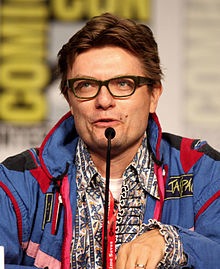
[Editor's note: just to finish things up, we know what it's like in the trenches for us regular folks, but what is Comic-Can like for a celebrity? For the second time, actor James Urbaniak was gracious enough to pen a Comic-Con diary for us, cracking the door a bit on the glamour and glitz of life in the green room. Probably best known as the voice of Dr. Venture on the Venture Bros, Urbaniak has appeared in everything from American Splendor to The Boxtrolls. He can currently be heard on his podcast, Getting on with James Urbaniak. These are his con adventures.]
Dream: I am in a room full of food. Mike Tyson talks to Sponge Bob. Nearby, Leonard Maltin eats a sandwich.
Oh wait, it’s not a dream, I’m in the Adult Swim green room at Comic-Con. This is the room at the Hilton Bayfront where anyone on an Adult Swim panel hangs out before or afterward. Mike Tyson (who stars in an upcoming Adult Swim animated series) is talking to Sponge Bob (well, Tom Kenny) and Leonard Maltin is floating about. It’s not a dream, but it does feel deeply symbolic. Of what, I have no idea.I ask Leonard Maltin if he knew Pauline Kael. He explains that he never met her but talked to her once over the phone.
Maltin is moderating a panel with Triumph the Insult Comic Dog. Also on the Maltin panel is Jack McBrayer, whom my girlfriend Sara Pocock had noticed peripherally in an elevator earlier that morning when we’d checked into the hotel. She was adjusting a wedgie at the time (she tweeted about this so I’m okay to bring it up). Later in the green room she officially met him and mentioned that the three of us had earlier shared an elevator while she shimmied to adjust herself and he replied with the same artless Southern enthusiasm as 30 Rock’s Kenneth “Oh yeah, I remember! You were dancin’ in your blue jeans! This is my first time here. It’s craaazy!”

We took the train from LA early that Friday morning. At the platform there was guy in a Flash t-shirt, a guy in Superman t-shirt, guy in a Star Wars t-shirt and a boy in a Magneto helmet. While boarding I heard a guy say “Should I change into my Sailor Moon suit on the train?” I think he was joking. Near the food car, three middle-aged people dressed as Power Rangers asked me to take their picture.
Back in the green room, Maltin is telling a story about his Bullwinkle watch. I say hello to Dan Harmon. My colleague from the Thrilling Adventure Hour, ubiquitous voice actor John DiMaggio is now conferring with Tom Kenny about Mike Tyson. (BTW DiMaggio’s mother and my father both taught special ed in the same school in the 70s but that’s another story.) I meet Robert Smigel. Rob Corddry is there. Travis from “Clueless” walks by. “Oh my God,” says my girlfriend. “It’s Travis from Clueless.”
I am there for the Venture Bros panel. Doc Hammer and Jackson Publick enter the room, dandified as usual. Jackson in seersucker, Doc in one of the personally tailored suits that fit his narrow frame like a second striped skin.
“Hello boys!” I exclaim. I ask Doc how his train ride was. He takes the train from New York to San Diego (he doesn’t fly; ear issues.)
It’s a classic Venture Brothers panel. The boys go off on peripheral tangents and lightly chastise anyone who wants details about the upcoming season. (Jackson does allow himself to reveal some of the season’s upcoming guest stars. Google it.)
They show a video of Jarvis Cocker referencing the Venture Brothers in a Pulp concert. After the clip I tell a story about how a drunk guy in a bar once mistook me for Jarvis Cocker. For some reason the context of a Venture Brothers panel this highly amusing anecdote doesn’t land so I bring it up about three more times during the course of the hour. Pointless tangents are a hallmark of our panels.
After the panel Sara and I make our way to the Convention Center past the zlpline and the giant half a Homer Simpson head that protrudes from the lawn between the hotel and the center (promoting FXX’s “Every Simpsons Ever.”) And here it is, the Center, “the floor,” the belly of the beast. We pass beneath the banner reading “Welcome to Comic-Con International” in not-quite-Comic-Sans. The last time I was here, two years ago, I saw a group of Venture Bros cosplayers as soon as I walked in. History repeats itself. There, as if waiting for me, are the Monarch, Dr. the Mrs. Monarch, Dr. Venture, Pete White and Dr. Henry Killinger. Someone gently admonishes me to get out of the way of their photographer. This dark irony is not lost on one of the players who says “He’s on the show!” I take my own photo of them.
Sara and I begin the gritty work of walking the floor. We stop by the tables of various artist friends. Mike Mitchell, Drew Friedman, Shannon Wheeler (illustrator of Mark Russell’s “God is Disappointed in You,” for which I recorded the audiobook) and the legendarily eccentric Tony Millionaire, who is wearing someone else’s nametag. “Using a pseudonym?” I ask him. He removes the tag as if he hadn’t noticed, crosses out the incorrect name and then, in a very slow and careful hand, writes “TONY MILLIONAIRE.” Good thing I said something.
Cosplayers abound. Of particular note are a very convincing Drogo and Daenerys. They are uncanny physical matches. “That Drogo could really pull off Brock Sampson,” I think to myself.
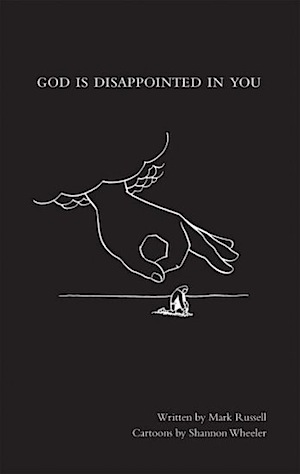
Sara runs into an old friend named Zoe from the CalArts animation program who tags along. After a couple of hours on the floor, we are ready to recharge at the bar at the Hilton (the Odysea). Sitting on the deck looking overlooking the bay, we observe a helicopter land on a yacht. This over-the-top metaphor for the corporatization of Comic-Con is a bit on the nose but we’ll take it. More rounds are bought. Our LA friends David and Augusta Avallone show up. Jackson Publick makes his way over.The aforementioned Mark Russell joins us and I meet the author of my audiobook for the first time.
I have a panel for the Thrilling Adventure Hour that evening (the LA-based old time radio-style comedy show/podcast has a crossover performance with Welcome to Night Vale the next night). This panel is a bit less randomly freewheeling than the Venture Bros panel and I keep irrelevant anecdotes to a minimum.
Panel done, it’s back to the Odysea where a Disney party and a fan-organized Venture Bros costume party are happening simultaneously. I spy a group photo about to be taken of a couple dozen Venture Bros cosplayers and I jog over and slide into a crouching position in the foreground right before the click. It’s about 10 pm and Sara and I are both hungry and tired. We tell friends at the bar that we are going to our room to order some dinner from room service and will be back. In the room, we both fall asleep while waiting for the food. While eating dinner, Sara sleepily says “You know…we don’t have to go to a party tonight.” We conk out and are asleep by 11:30 pm. Day One is over. I dream of Leonard Maltin.
Up the next morning for a Venture Bros signing. Jackson and Doc are always in great form at these one-on-one interactions with fans. Of the three of us, Doc has the most impressive signature.
After the signing, Sara and I wander Artists Alley. We meet the delightful Paul Guinan, creator of the fictional Victorian robot Boilerplate. We chat with my old friend Todd Stashwick, actor and co-creator of the online comic “Devil Inside.” (We played a pair of pervy bad guy friends on an episode of “Law and Order: Criminal Intent” many years ago.) Making our way outside, we go to the nearby Disney Infinity Pop Up Shop where Sara’s old CalArts classmate, “Gravity Falls” creator Alex Hirsch is signing posters. I get two for my 8-year-old boy/girl twins; it’s their favorite show.
We ping-pong back to the Odysea where Rob Corddry and his wife Sandra are at the bar. Corddry and I get into a deep discussion about novelty records (Weird Al had the #1 song that week).
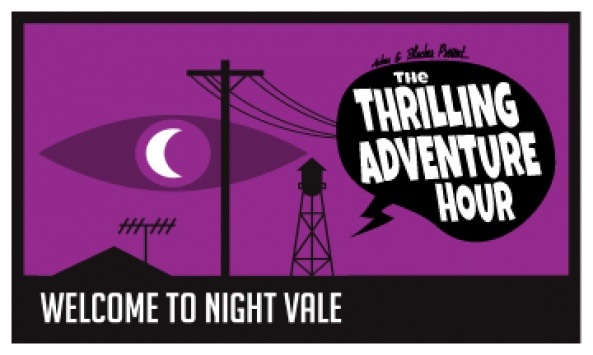
That evening I play a Western robot space outlaw in the Thrilling Adventure / Night Vale show. Mingling afterwards in the lobby, I spot David Rees and Ken Plume (for whom I will be participating in various DragonCon events next month). Afterwards, Sara and I go to a carnival-like Adult Swim party in the PetCo parking lot across from the Convention Center. There’s a fun house (one room features a large reclining man dressed like a baby) and a “Meatwad Dome,” a large domed tent-like structure where you lie on the floor and a psychedelic planetarium show hosted by Aqua Teen Hunger Force’s Meatwad is projected on the ceiling. The word is overused but one can only call it trippy. This party in a parking lot also features free t-shirts, free ice cream and free warm beer (they ran out of ice). We run into a ton of people. This is the parking lot to be in tonight.
We stagger across the street to the Hilton (holding a “Black Jesus” candle that a hipster Santa offered me in the funhouse). The aforementioned Todd Stashwick, artist Denis Calero and our friend the writer Deric Hughes have a floating party every year they call Slam Con and, since all roads lead to the Hilton this year, that’s where they’re at. But the Odysea is closing and the guests are dispersing. The road of excess leads to the palace of sleep.
I have another Venture Brothers signing on Day Three at the Entertainment Earth booth (manufacturer of Venture Bros action figures and shot glasses). A small curtain has been set up in front of our booth table and Jackson, Doc and I are formally revealed when the signing begins. When the signing is finished, the curtain closes. Jackson laughs at the absurdity. I, an old theatre actor, feel warmly at home.
The rest of the day is spent browsing the floor. We make a couple of purchases at the Fantagraphics table and head back to pack for the train back to LA. Our driver to the train station says she’s been shuttling people back and forth between the Center and the train station all weekend but she’s never been to the Con herself. Had Jackson Publick not offered me the role of Dr. Venture in the Venture Brothers one evening in a New York bar over ten years ago, it’s likely I may never have made it here either. As the train brings us back home, I bid goodbye to the weird, waking dream. Somewhere Leonard Maltin smiles.

[Follow James Urbaniak on Tumblr and Twitter.]
Blog: PW -The Beat (Login to Add to MyJacketFlap)
JacketFlap tags: Fandom, Top News, virgin diaries, SDCC '14, Add a tag

by Chandler Banks
[Ed. note: Chandler Banks is a 17-year-old cosplayer/journalist who went to Comic-Con for the first time this year, and agreed to share her experiences with us. Although folks in the comics business have our own dread and anxiety about The Big Show, it's important to remember that for many people, it's a magical experience. I'm sure you'll be as fought up in Chandler's enthusiasm as I was.]
Before SDCC this year, I was a long-time nerd that had never been to a convention. And man, did I pick a hell of a con to start with. As a 17-year-old girl bound to a dinky little knee scooter for the weekend thanks to a recent ankle surgery (if you’re reading this and you were there, yeah, that was me), I knew I had a weekend ahead of me that was as exciting as it was daunting. I had a general idea of what SDCC is about, but in the end it was bigger and better than I had imagined in just about every way.
WHAT BLEW MY MIND
• The size. I live in New York; I’m no stranger to grand scales. But the image of SDCC that I had built up in my head was nothing compared to the view in the exhibit hall alone. Art, comics, collectibles, apparel, further than the eye can see. It’s its own world that’s so easy to lose yourself in for the weekend.
• The cosplays. I, like most people, got to the exhibit hall early in the morning before it opened so as to get my badge as early as possible. I’ve seen hundreds and hundreds of pictures of to-die-for cosplays online, but seeing all of them in the flesh (or paper mâché) is entirely different. Honestly, I wish I would’ve alotted myself more time for open-mouthed gaping on the sidewalk.
• The great outdoors, but with free wi-fi. When packing for the con, I asked my convention veteran friends for advice. They told me two things: Leave room in your luggage, because you’re going to buy a ton of merch’, and if you’re sleeping out on the Hall H line, pack as if you’re going to spend the night in the woods because it’s like camping just nerdier.
• Speaking of friends, I got to meet my GISHWHES (Greatest International Scavenger Hunt The World Has Ever Seen) team for the first time. They’re even cooler than I thought they’d be, and they’re really my closest friends that are into comics and “fandom” the way I am. I had my friends and was surrounded by a whole slew of people with the same interests as me for the first time. Talk about liberating!
• This is the first time i’ve seen any big celebrities in the flesh. I gave Mary J. Blige’s dad a ride home from Dunkin Donuts once (he turned out to be pretty cool), but that’s about it. This weekend I got to see these people that I’ve respected and admired for so long up close and personal. Once it actually hit me, it was surreal.
• Contrary to what the internet made me dread, no thirty-something-year-old guy in a My Little Pony shirt and a matching fedora pointed to my Captain America shirt and declared me a fake geek girl. At least not to my face.m
• San Diego! I had only been as far south as Santa Monica in the past, and boy San Diego was a very pleasant surprise. The Gaslamp Quarter where the Convention Center is located is gorgeous, and there are plenty of off-site SDCC activities around in case you somehow tire of the exhibit hall and the panel rooms.
• Speaking of off-site, I’m going to take a second to gush about The Nerd Machine. Run by Chuck’s Zach Levi, for the past few years they’ve been offering the Nerd HQ experience for free. This year and the last it was held at the beautiful Petco Park (about a five minute walk from the Convention Center). The popular events there include Conversations for a Cause panels and Smiles for Smiles photo ops, both fairly priced and the proceeds of which go to Operation Smile. I went to the Supernatural panel this year, and it may have been the highlight of my already amazing weekend. It’s much more intimate than the Hall H/Ballroom 20 panels I attended since the room seats around 300 compared to Hall H’s ~6,100. The actors are more relaxed like this, tickets are sold ahead of time so there’s guaranteed seating. No camping out! Just get there in time for the panel if you have a ticket, and if you couldn’t get one they usually let around 50 people in for standing room. If any celebrities you’re interested in ever have a Nerd HQ Conversation, you won’t regret going. Or maybe just use the beautiful Petco Park as you and your friends’ home base and hang around the gaming gallery. They also have some pretty killer merch’.
• You never know who you’re going to see. Stephen Colbert surprised everyone as the moderator for the Hobbit panel. I accidentally got on line for a George RR Martin signing. Aisha Tyler surprised us as the moderator for the SPN Nerd HQ Conversation (I sat two feet from her. /screams). You can meet and chat up with comic industry legends (I got a Thor drawing signed to me by Neal Adams). There was a guy hanging around the Hall H panel that I suspected was Osric Chau from Supernatural (because that’s exactly the kind of thing he would do, so naturally, I took a selfie with him. Spoiler alert: it was actually Osric Chau.

• The whole atmosphere surrounding the event. Now here’s where I get really sappy: As great as it was to see all the work that artists and fandom merch retailers etc. brought, my favorite thing about SDCC was the overall atmosphere of the convention. It’s not about bringing a wad of cash to California to buy all the merch you could get online just sans shipping, it’s not even about looking at all the cosplays (although don’t get me wrong- those seriously kicked ass). Because everywhere you go, you’re reminded that the industry could not and would not exist without the love the fans bring to the table. At every Hall H panel I saw, an actor or producer would set time aside to personally thank the fans for keeping them going, and express that they only hope that they deliver material worthy of them. Everyone’s there to immerse themselves in an environment built on and for an appreciation of art in some form(s). I met a couple that was going on their 8th year in a row attending together. They weren’t particularly die-hard fans of anything, they just liked what the convention is all about. It’s different things to different people at different points in their life. It’s seeing a community that otherwise lives in your laptop laid out before you. I must have turned to the crowd and declared “these are my people!” to my friends three times before they told me the joke was getting old (that didn’t stop me from doing it twice more, mind you).
BE PREPARED FOR
• Waiting in line. This is where it’s extremely handy to come with friends. If you’re in one of the bigger “fandoms” and know , it will probably have its panel in Hall H
• Poor health and hygiene. Everyone has a different experience, but as a first time con-goer I got absolutely caught up in doing as much as I possibly could before the convention ended. I got in late Friday night, slept in my hotel room. Them by 7:00 am Saturday I was getting my passes and going to the exhibit hall and queueing up for a panel in Ballroom 20 and then finagling my way into Hall H and freaking out over the Marvel panel’s SDCC exclusive footage and running out of Hall H to battle to get back in line for Hall H (hello darkness, my old friend) for Sunday’s Supernatural panel and trying to sleep while reveling in my own sweaty filth and getting a surprise cup of coffee from Misha Collins (he was wearing a wolf t shirt and a cupcake apron and he handed me a cup and suddenly I was someone who drinks coffee) and then going back to the exhibit hall (I could’ve spent all weekend in there and not seen anything) before having to run across the street for a Nerd HQ panel and going back to the exhibit hall to soak up as much as I can before it closes until next year, and THEN maybe stopping to realize that you haven’t eaten or slept* or maybe even breathed in 48 hours.
• To clarify: I wouldn’t change any of that for the world. Just be prepared for it is all.
• *DISCLAIMER: there are plenty restaurants and sleeping accommodations in San Diego, and I’m a girl that loves her food and sleep. But my friends and I were simply too busy to even remember that hunger and sleep-deprivation were things.
• Line drama. For the smaller halls, this isn’t real an issue, but I’ll give you a rundown of how Hall H works. SDCC’s getting bigger each year, so the infamous Hall H lines get more hectic each year. The line for Saturday’s panels included big hits like Marvel and The Hobbit, so the line started at 11:30 a.m. on Friday. People start forming “unofficial” lines off-site as early as they could so they can be at the front, and those lines get dispersed until such a time that security declares it time to select an unofficial line to be the official unofficial line that will be the line moved to the tents on-site where the official lines stay for the night. One security guard will tell you you’re on the right line, then another security guard will come along an hour later and tell you you’ve been on the wrong line this whole time. Sorry, bud. It’s just as confusing and chaotic as it sounds. Worth it? Totally.
• Spending money. I spent all of mine. I would have spent more if I had more. I needed to buy all the things.
• A lot of walking. Especially since I was handicapped for the weekend, it takes its toll. Wear comfy shoes, unless comfy shoes don’t go with your cosplay. Then you work that cosplay.
WHAT I’M TAKING AWAY FROM THIS
I want to go back next year. Seriously, if you have the chance, go. I was anxious about going on one leg, but I’m so glad I didn’t let that stop me. What a wild ride.
Blog: PW -The Beat (Login to Add to MyJacketFlap)
JacketFlap tags: Benefits, Top News, SDCC '14, Add a tag
whata great event! helped raise over $10k for local san diego schools @sanfordgreene #sdcc #quiznos #QanvasbyQuiznos http://t.co/avW93mvE1R
— bernard chang (@thebernardchang) August 6, 2014
Here’s a nice story from Comic-Con about more than 50 comics artists including Bernard Chang and Sanford Greene, teaming up with QANVAS by Quiznos, an art project that saw them drawing on Quisnos sub wrappers. The resulting art was auctioned off to benefit ArtReach, and some $10,000 was raised for art programs in San Diego schools. Win win win!
Blog: PW -The Beat (Login to Add to MyJacketFlap)
JacketFlap tags: Photos, Television, Fashion, Dark Horse, Top News, SDCC '14, Add a tag
by
Pam Auditore
While at SDCC I could not help but notice the grumbling across Social Media of how little seemed to be coming out of SDCC in real time, and how deeply missed G4 was as a result. For those of us trying to bridge the gap, their seemed to be insufficient band width in Downtown San Diego for bulk loading from personal devices. This is a question worthy of its own article, but right now, it’s my pretext to finally upload more images from the Exhibit floor and Outside the Convention. 
Blog: PW -The Beat (Login to Add to MyJacketFlap)
JacketFlap tags: Interviews, kickstarter, Indie Comics, Top News, SDCC '14, Add a tag
By Matthew Jent
Ben Costa is a maker. He makes comics, games, and deadpan jokes.
I caught up with Ben at the tail end of this year’s San Diego Comic Con to chat about the Kickstarter-funded second collection of Pang, the Wandering Shaolin Monk, his new webcomic Rickety Stitch and the Gelatinous Goo, and making the kinds of games you want to be able to play.
Ben exhibited in the Small Press area of SDCC as Iron Crotch University Press.
How long have you been coming to SDCC?
I’ve been exhibiting for five years. I attended for a few years before that.
How’s your show been this year? What are you most excited about?
The Sakai Project. I have an illustration in there, and Stan Sakai has been one of my inspirations for a long time. Every year everyone says the show isn’t about comics anymore, but it’s still one of my best shows of the year.
And that’s probably because it’s five days long? It’s usually consistently good, but this year wasn’t the same way. Wednesday through Friday were kind of bad. A show like SPX is my best show, per day. One day at SPX I sold 40-something books, which I don’t do at San Diego.
But there were noticeably more people coming through Saturday and Sunday. The aisle would get full sometimes. And on Sunday, it felt like a bunch of people who have walked by and maybe didn’t buy anything came by, like, “Alright, I’ll take that print.” So I sold a bunch of prints on Sunday, whereas on previous days it was very few prints.
Do you still mostly sell the first volume?
Yeah, it seems that way. 90% of people coming past still seem like they have no idea what it is. One out of ten people will be like, “Kung-fu, this is awesome!,” or I’ll recognize them from previous years.
The last time we talked, your Kickstarter had been successfully funded but the book wasn’t out yet. How has the publication of volume 2 of Pang been?
Pretty good, overall. It’s been a little harder to get the word out than the first volume. It seems to be getting less press. I got several reviews from the first one, but I’ve only gotten one for the second one. I sent out review copies for both books. It wasn’t ordered into as many comic book stores. But both volumes were in Previews, and both volumes were Previews Staff Picks.
Pang started online, and you’ve self-published the two hardcover volumes that are currently out. Are you interested in working with larger publishers, or doing more work-for-hire projects?
Work-for-hire, on the right project. Like if it was Star Wars, or Teenage Mutant Ninja Turtles — sure.
Twist your arm, and you’ll write Star Wars. Do you have a Turtles story you’re dying to tell?
No? I’ve never been a great plot generator. If I sit there a long time and think about things I can come up with stuff. But the relationships are what draw me in. But with Turtles, you can also have cool ninja fights.
A lot of Turtles stories, after the first 10 original issues, are good stories, but they don’t get the core of the characters. What’s at the core for me.
What’s at the core of a good Turtles story?
They’re brothers. And Raph, he jokes and acts like he’s having a good time, but really, you know — it’s painful inside. So it’s that family dynamic.
Let’s talk about webcomics. Your new project is Rickety Stitch & the Gelatinous Goo.
It’s a fantasy. It’s about a skeleton minstrel and his trusty gelatin sidekick.
You’re serializing it online, like you did with Pang — do you want to collect it as a physical volume somewhere down the line? Or partner with a larger publisher to put it out?
There are webcomics that gain enough of a following that when they produce merchandise — books, shirts, prints, whatever — they can make a living through their audience without having to go through a publisher. But you have to be really popular, and it’s geared more toward gag comics that update every day. Although there are exceptions.
I didn’t want to work on this, get it to a publisher, then have wait and just be silent for 2-3 years while everyone forgets I exist. So, we’re putting it online. I dunno if that will effect how a publisher might react to it later. On the first volume of Pang — the beginning is a little rough, compared to the rest of it, so I could see why publishers might not want it. But once I self-published the first volume, the vibe I got was always, “This is great. Show me what you’re doing next.”
The question I have is — at what point do you start pitching it? I feel like comic book publishers like to get in early on the editing process. When you have a novel, you’re supposed to just write it, completely, and then show it to people. But with comics, it seems like they don’t want to see a completely finished thing.
Is it fun to make? Rickety Stitch?
Yeah, it is. James Parks, my co-writer, and I could have easily let this project die. We showed it to Slave Labor a while back, and they turned it down. But it was so fun to make that we wanted to just do it.
The Pang table-top role-playing game was a Kickstarter reward, and you’ve been selling some physical copies at the show this year.
One of the guys from Fantasy Flight came by and bought a copy. He says they have a group there that gets together and plays indie games.
Are you interested in game design? Or is it more about adapting the story and the spirit of Pang, and fitting that into game mechanics?
Adapting the story and spirit is more appealing to me, though I do like design mechanics. My friend Amir Rao, from Supergiant Games, is my regular Dungeon. All his life he’s been making games and RPGs that we would play. It rubbed off on me.
What did you approach adapting Pang’s story and turning it into a game?
The obvious things is kung-fu fighting. I wanted to have a combat system that felt different, that wasn’t just “I attack, you attack, I attack.” I wanted defense to be something you actively think about.
Having played it — it feels like really squaring off with an opponent. You spend points or save them, and you can react based on your opponents actions. You can hold back and defend, or make a big offensive move but leave yourself open to be pummeled.
I thought there was good opportunity to make abilities around that. And trying to make it feel Ancient China.
How did you do that?
I started with choosing stat names that were a little different. Stuff you couldn’t just pin down as exactly representing the skills. Like “Benevolence” — you can’t exactly know what you would put under that off the top of your head. It was a long process. It took way longer than I thought it would.
I also made a Star Wars game, for fun, from which I pulled a lot of the abilities for Pang. I made a Rickety Stitch game, then Star Wars, then Pang. So I have a fully functional Star Wars game.
When did you make a Star Wars game?
2012?
Why did you make a Star Wars game?
I had three-year campaign in the d6 system that was great, but we could probably never play it again. I started working on the new game towards the end of that. I’d added a bunch of custom rules to the d6 game, which has no classes. I added a “rebel ranks” ability system, so as you go through the ranks with rebels you get new powers. Sort of like Pang, they build on skills. You use your skills to activate them. Same idea as the Class Masteries in Pang.
It was sort of in response to the Fantasy Flight game, because I’d gotten the Beta book, and I was really excited about it, but for my own personal taste there was something lacking. I’m particularly proud of the space combat, which in my own games, has not been satisfying.
I like that spirit. If there’s something you don’t like, you just create the thing you do like.
I justified it to myself by saying I would use this game for a science fiction comic I want to eventually do.
I love it. Almost everyone else in comics is making a comic book to spinoff into a movie. And you’re making comic books so you can spin off role-playing games.
It’s like the way to not make money.
The hope — in any of my games — is to capture the abstraction of the story.
Blog: PW -The Beat (Login to Add to MyJacketFlap)
JacketFlap tags: Image, Breaking News, Top News, Descender, Jeff Lemire, Image Comics, Dustin Nguyen, SDCC '14, Add a tag
 By Kyle Pinion
By Kyle Pinion
Announced at Image Expo this year at San Diego Comic Con, Jeff Lemire’s first ongoing series with Image, Descender, is described thusly:
Ten years ago massive, planet-sized robots called “The Harvesters” materialized without warning and invaded the orbits of all the United Galactic Council’s worlds wiping out entire planets and civilizations before disappearing again. In a fear-fueled response to this machine holocaust, the galaxy blamed millions of robotic companions, whom they suspected of somehow spawning The Harvesters. All robots and androids were immediately outlawed and ruthless bounty hunters called Scrappers were charged with scouring the universe for any surviving robots.
The incredibly life-like artificial boy, TIM-21 may hold the secrets to the origin of The Harvesters deep in his machine DNA—and as a result is the most-wanted robot in the universe. With only his small pet-bot, Bandit and the lumbering mining droid, Driller at his side, TIM-21 goes on the run. Before long the entire galaxy is looking for this rag-tag group of unlikely companions, as they make their way from one exotic planet to the next with new foes advancing on them at every turn.
Lemire and I chatted briefly about this exciting new series as a third part to our earlier discussions about his upcoming DC Comics work and The Black Hammer at Dark Horse. We discussed some of the sci-fi direction of the series and just why the child-protagonist was such a key choice for Lemire and his collaborator Dustin Nguyen.
What triggered the idea for Descender? How long has it been percolating?
Descender actually started as an idea for a company owned character. Then I realized as if changed and grew that it was becoming something totally different and I would be better served to go all the way and make it into a creator-owned project. I’m drawing a 200+ page graphic novel for Simon and Schuster right now called Roughneck, so I knew I wouldn’t have time to draw Descender or The Black Hammer so I decided to try working with other artists whom I admire and want to work with.
With Trillium, Justice League United (to an extent) and now Descender, you’ve started to edge more towards science fiction, is that a major area of influence for you as a writer?
My work has always drifted towards genre. Even the first Essex County had scenes that were steeped in “magical realism” or genre. And I would argue that Sweet Tooth and Nobody were sc-fi too. So I don’t see this as a move towards sci-fi. And having said all of that, Roughneck is probably the most grounded thing I’ve ever done. No genre elements at all.
But, I do see what you’re saying in terms of “space-based” sci-fi. What I liked most about Trillium was the world-building, so Descender will allow me to develop and create not just one alien planet or race, but dozens.
I also seem to be reading more and more sci-fi lately. Dan Simmons has become a big influence. His “Hyperion” books blew my mind.
It’s difficult to pave new ground in science fiction, what are you hoping to contribute to the genre with this series?
Honesty, who knows? I don’t go into something trying to make a big statement or contribute to the genre, I just try to tell a good story. One that I like and would want to read. What it becomes beyond that is beyond my control.
I will say that I intend to use space opera here the same way I used the post-apocalyptic genre in Sweet Tooth. The genre elements will be the backdrop and the focus will very small, character based work.
What is it like to write from both the perspective of a child and a being that isn’t quite human?
I’ve always enjoyed writing kids. Right from the first Essex County. It just seems to be something I’m comfortable with and something that comes naturally to me. TIM-21, the lead character in Descender, is no different. He is probably the most “human” character in the book. At least at the beginning of the series. That may change as the book unfolds.
Androids aren’t often portrayed as children, ‘AI’ excepted, what made you decide to make Tim a child? And what differentiates a child android from an adult android in this context?
See above. I love writing kids and I love exploring story through a child’s point of view. That sense of innocence and wonder and awe. What a great way to explore big sci-fi ideas. There are so many different types of robots and androids in the book, not just human-looking androids or adult/child androids. And they all have different functions, personalities and motives.
What is the aesthetic of the setting? We’ve seen outer-space set stories in western like backdrops, steam-punk, Blade Runner type dystopias, clean minimalism and so on. Is there a particular direction that informs the universe of Descender?
All of the above. Each world and each planet they come to will have a different aesthetic and look. It;s a great way to keep the story fresh and let Dustin really cut loose. One planet may be a aquatic planet, the next issue they may be on a space-port that is like deep space old west. It just keeps reinventing itself.
What do you think, or hope, Dustin Nguyen will bring to this overall vision? Was he instrumental in the development of the concept, or did he come on-board afterwards? If the latter, did it change in any significant fashion from his involvement?
Dustin brings an incredible amount of humanity to the characters. Just look at that promo image. The look on TIM-21′s face is something I could never describe in a script. It’s just so perfect. He is also an incredible visual story teller.
It’s funny, I like to write kids and i knew from his sketchbooks, Lil’ Gotham etc… that Dustin likes to draw them. So it was a perfect match.
Does Descender center on humanity specifically, or will readers get an opportunity to see alien races as well?
Humanity is only one race that is represented in the book. The galaxy we focus on has a dozen planets, each with it’s own race and culture.
Are there any particular scenes or moments that you’re very excited for people to read?
The opening sequence in issue 1 is pretty “big” in scale. I can’t wait to see how Dustin draws it. And the cliffhanger in issue 2 is pretty good too.
Descender will debut in March 2015 from Image
Blog: PW -The Beat (Login to Add to MyJacketFlap)
JacketFlap tags: Culture, Podcasts, Image, Jaime Hernandez, Gilbert Hernandez, Top News, Image Expo, more to come podcast, SDCC '14, Add a tag
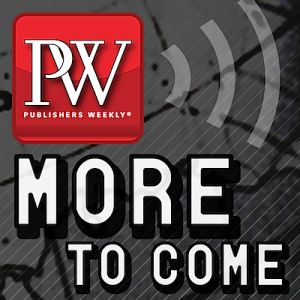 Recorded at Publishers Weekly, it’s More To Come, the weekly podcast of comics news, interviews and discussion with Calvin Reid, Kate Fitzsimons and The Beat’s own Heidi MacDonald.
Recorded at Publishers Weekly, it’s More To Come, the weekly podcast of comics news, interviews and discussion with Calvin Reid, Kate Fitzsimons and The Beat’s own Heidi MacDonald.
In this week’s episode, the More to Come Crew discuss 2014′s San Diego Comic-Con including the long-awaited Eisner award vindication of Jaime and Gilbert Hernandez, Image Expo and indie comics, a slightly smaller presence for offsite TV and video game hoopla, digital comics, the con experience and convention safety concerns.
Download this episode direct here, listen to it in streaming here and catch up with our previous podcasts on the Publishers Weekly website, or subscribe to More To Come on iTunes
Blog: PW -The Beat (Login to Add to MyJacketFlap)
JacketFlap tags: Sonny Liew, First Second, Breaking News, Boxers & Saints, The Shadow Hero, Gene Yuen Lang, American Born Chinese, Top News, SDCC '14, Add a tag
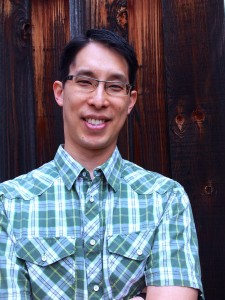 By Kyle Pinion
By Kyle Pinion
Gene Luen Yang is the writer/artist of critically acclaimed graphic novels like American Born Chinese and Boxers & Saints, as well as the writer of Level Up, The Eternal Smile, and adaptations of Avatar: The Last Airbender. Yang’s work has been awarded with multiple Eisners including “Best New Graphic Album” for American Born Chinese (which was also the first ever graphic novel finalist for the National Book Award in Young People’s Literature) and for “Best Short Story” for The Eternal Smile. This year, Yang was nominated for another Eisner, this time under “Best Publication for Teens (aged 13-17)” for the historical epic Boxers & Saints.
Additionally, 2014 saw the debut of his latest graphic novel, The Shadow Hero, a collaboration with artist Sonny Liew on a resurrection of the sadly forgotten Golden Age super-hero: The Green Turtle; a character who comics fans consider the first Asian American superhero.
I was fortunate enough to be able to spend time with Yang to discuss the origins of this new work, his collaborative process with Liew, as well as delving into some of the intricacies of Boxers & Saints and some of the connective tissue between his two most recent projects.
You’ve spent your career working on affairs of an educational nature, or towards a young adult audience, what was the impetus to delve into Superhero comics now?
I love superheroes. I grew up reading superhero comics, and starting collecting superhero comics in the fifth grade. I was a Marvel guy all the way through my childhood. I’m not totally sure why it took me so long to get to superheroes. There were a couple of opportunities that showed up maybe a few years ago, but the timing was just never right. This felt like a door opening. All of this pent up superhero energy that I had as a kid was finally released.
These other opportunities, were they mainstream superheroes?
Yeah, there were a couple of mainstream superhero opportunities where the timing was just never right, and in some ways, the Dark Horse book that I do: Avatar: The Last Airbender is about super powered young people, so there’s a lot of overlap between Avatar and traditional superheroes. But as for The Shadow Hero, this is really solidly in the genre and something that I just really wanted to do for a long time. I’m not totally sure why it took so long.
When did you first discover the work of Chu Hing?
It was online. Like how most of discover a lot of stuff on the internet and several years ago a good friend of mine, Derek Kirk Kim pointed me to this blog post on a site called “Pappy’s Golden Age Comics Blogzine”. It was a feature about this obscure character from the 1940’s called “The Green Turtle”. The Green Turtle was created by Chu Hing and the rumor was that Chu wanted him to be a Chinese American superhero but his publishers wouldn’t let him do it. So, he draws this comic in this really funky looking way, where he’s constantly hiding his face from us. The rumor was he did this so that he and his audience could imagine The Green Turtle as a Chinese American. When I read that blog post, I was just fascinated. I was fascinated by the character himself, and I thought his character design was so “Golden Age” with his bare chest and the cape and everything. There’s something endearingly goofy about it. And the rumor surrounding his creation I found fascinating as well.
What were some of the challenges you found in crafting an origin story for a character that had none, as I think Chu Hing crafted only a few stories at most?
Yeah, he did five, but they were only 8 pages long each. And each issue, he has this sidekick named “Burma Boy” and every time Burma Boy asks the Green Turtle for his origin story something interrupts him. So yet, there’s another thing that’s being hidden from you. It felt like it was very rich, the original material that is. There are all these weird little pieces that I wanted to try and puzzle together. There’s this other bit, he has this turtle shaped shadow that follows him around. In the original comic, there’s no explanation given for this thing at all, it was almost like a design artifact. I thought there was something there that I wanted to explore.
What were some of the influences that helped form this tale? You mentioned that you were a superhero fan growing up…
I think a lifetime of reading superhero comics was really the influence and in The Shadow Hero we wanted to play with a lot of the tropes and a lot of the conventions of the genre but aiming to present them in a new way.
Hank’s (the Green Turtle) family was one of the highlights of the book for me, and they were so well fleshed-out. I know you sometimes pull from your own life experiences, for example in American Born Chinese. Is that the case with Hank’s supporting cast?
Yeah, absolutely, I don’t know how to write outside of my own life. Even if the story is very fantastical or set in a fantasy world, I still feel like the origin of it has to start from my own life. For Hank’s family, his mom is this very opinionated person who comes from a really good place. But she has all these ideas about how he should live his life. She’s actually based on these women that I knew in a church that I grew up in, these Chinese and Chinese American women. Who were all very well intentioned, but had very strong opinions about your life.
Were they equally as hilarious as Hank’s mother?
As a kid, I found them simultaneously hilarious and terrifying. (laughter)
Where did Sonny Liew come into the picture?
Sonny and I had collaborated together. We did a short story for an anthology called Secret Identities. It was a collection of stories about Asian American superheroes by Asian American creators and I enjoyed that process of working with him so much that I wanted to do it again here. After I started writing the outline for The Shadow Hero, after I started talking to First Second about it, they asked who I wanted to collaborate with. Sonny was at the top of my list. I just thought he had the perfect combination of the comedic and dramatic, and I thought he would be perfect for the story.
Was there ever any consideration for you taking on art duties yourself?
I thought about it for like two seconds, but I just don’t think I could pull of what Sonny can pull off. He’s amazing!
Between the two roles, when you are the writer/artist on a piece of work vs. when you’re writing the story with someone else taking on the other half of the duties, does it differ your approach at all? Was it a matter of giving up some control so Sonny could craft his own vision of your words?
Absolutely, when you work with someone else, you expect the final voice that comes out to be a mixture of the two people that are working together. And then, for something like Boxers & Saints, where I did all of the writing and the drawing, I had a really personal vision that I wanted to throw out. I did work with someone on that as well, as even Boxers & Saints was a collaboration with a colorist named Lark Pien, who is amazingly talented. The Shadow Hero, we’re hoping, is more of an expression of our friendship, of something that’s between the two of us.
Do you have an approach that you prefer?
No, I think it depends on the story. Like with The Shadow Hero, I just don’t think I could have pulled that off on my own. I really think having both Sonny and I together was the right way to go?
Do you work from a script when you collaborate with another artist like Sonny?
I gave it to him as thumb-nails, but the thumb-nail sketches that I sent to him were pretty basic. Everything was laid out on a six-panel grid and he was the one that sort of innovated on top of that.
Will there be more of The Shadow Hero in the future? A possible sequel?
I’m not sure yet, I hope so. I really love working in that world and that character, but a lot of that depends on Sonny and his schedule. He has a lot of deadlines that he’s trying to make right now. It also depends on how this first book does and what First Second thinks.
Sonny teased me on Twitter about it and got my hopes up for a Part Two or an on-going series of some kind.
I would love to keep working with him.
Just to circle to the other half of the reason you’re here is because of your Eisner Nomination for Boxers & Saints, which I’m a massive fan of as well, and from a personal side of things it was an area of history I didn’t know much about…
Well, thank you, I didn’t know much about the Boxer Rebellion either when I started that project. I vaguely remember hearing about it from high school history. The reason I got interested is, I grew up in a Chinese Catholic community and in the year 2000 Pope John Paul II canonized a group of Chinese Catholic Saints. It was the very first time that Chinese citizens had become canonized, which my home church kind of freaked out about. When I then looked into the lives of these Saints, I discovered that a lot of them had been martyred during the Boxer Rebellion. They were specifically martyred because they were Easterners that had embraced Western faith. I felt like that whole incident kind of embodied this clash of Eastern/Western thinking that I personally have struggled with as an Asian American, for someone that has a foot in each culture.
It’s also a beautifully even-handed approach though between both sides. You display the heroism of those “Boxers” in the Boxers book, but in the Saints volume you see the aftermath of their actions and the people they are slaughtering. Was it your aim to display both sides in this fashion?
That came out of my own ambivalence. When I was reading about the history of it, I was so ambivalent, I was trying to find a hero and I couldn’t figure out who that hero was or what side that hero was on. That ultimately caused me to decide that I had to do two books.
The second book, Saints, is a little more monochromatic looking in its coloring, was that all Lark or a decision you made together?
That was a decision we made together. I really wanted the first book to feel almost like a comics version of a Chinese War Epic. I don’t know if you’ve ever seen one, but they’re always really long, really colorful and really sad at the end. That’s how I wanted that first book to be. The second book I wanted to be much more personal. I wanted it to be humble in every sense of the word; smaller, lessened scope than the first book, and I really wanted it to feel like an American Independent Comic. I feel like a lot of that type of comic has a limited use of color that establishes a sense of intimacy between the reader and the creator, that’s what we were going for.
The books also take a similar approach to faith and religion, I was particularly struck by the panel of Jesus Christ with the eyes on his hands, which hearkens back to the fable that was brought up in the Boxers book. How much of your own religious belief was brought into this work?
Faith is an important part of my life, its one of the major pieces on which I build my own identity. When I was in college, I really struggled with this, with how to write about faith in an authentic way. Anytime I would try to do it, it would come out really stale and preachy. I had a writing professor who was a Buddhist, she basically gave me the advice: “You should live your faith, and you should write your life”, and that’s what I’ve tried to do ever since. For the piece that you’re referring to, that was inspired by an actual piece of artwork I saw at an Asian art museum years and years ago. Guanyin, the Chinese Goddess of Mercy was surrounded by this halo of hands with eyes in the palm. When I saw that I thought that looked so much like a crucified hand, that looks so much like the imagery I was surrounded with in a Western church. I wanted to explore that connection. That image with a hand with some kind of hole or an eye, it’s independent of faith. It’s found in all sorts of world faith traditions and it’s a very interesting thing.
As a sort of common denominator between the two works (Boxers & Saints and The Shadow Hero), you delve into magical realism a bit. When I read the first chapter of The Shadow Hero, I found some point of comparison between yourself and Gilbert Hernandez’s Palomar stories.
Oh, I love Gilbert Hernandez, love him!
Me too! Is the choice to aim towards magical realism in these tales a conscious choice or is it a natural off-spring from what might start off as a more grounded idea?
It has to come out naturally. I think it comes about growing up having read superhero comics and being really big into fables and stories that I inherited from my parents. I think it just kind of comes out and it feels natural to me to aim for Magical Realism in the comics.
Are there other influences that you draw from other than Los Bros Hernandez?
I could give you a list of cartoonists as long as my arm: Osamu Tezuka, Jeff Smith, and a bunch of my own friends like Jason Sheehan, they all have influenced me in some way. Scott McCloud is a big influence too. As for stuff outside of comics, for that project in particular (Boxers & Saints), I kept thinking back to this novel by a Japanese Catholic Author named Shusaku Endo who wrote a novel called Silence. He deals with a lot of these same issues, including tension between East and West, what faith is, and what role it should play in an individual’s life and society. It’s a beautiful book.
Since we brought up the Gilbert Hernandez comparison, their work is often praised for its look into Latin American culture, and a lot of your work is focused on the Asian American experience be it the immigrant’s tale seen in The Shadow Hero, the historical background of Boxers & Saints, and the personal nature of American Born Chinese. Do you feel a sense of responsibility as a sort of vanguard of Chinese American focused writing in comics?
I think with all my books, I just really want to tell a story that will carry my reader from the first page to the last. And the way I know how to do that is to sort of write the things that are important to me. Culture and the intersection between culture is something that has always fascinated me and I think that’s where its always come out.
You’ve had a long relationship with First Second, why that particular publisher?
They’re amazing, you know we talk about this intersection between cultures, I really feel like First Second is like that in so many different ways. But one way is that they’ve published Asian comics, European comics and American comics. Their aesthetic is sort of a combination of all three of those different cultures. I feel like I fit here.
Any future projects you’re working on beyond The Shadow Hero?
I’m working on a middle grade comic book, it’s a series, and we’ve signed on for three books so far. I’m doing it with another cartoonist named Mike Holmes and it’s all about coding and programming.
That’s a whole area of your background we didn’t even get a chance to talk about, your Computer Science background. I hope that’ll be something we can circle back to next year!
That’ll be great!
Blog: PW -The Beat (Login to Add to MyJacketFlap)
JacketFlap tags: Interview, Interviews, Comics, Conventions, Top News, Leeds Thought Bubble, SDCC '14, Tula Lotay, Add a tag
by Zachary Clemente
Tula Lotay (aka Lisa Wood) is a comic artist hailing from the UK. Her work includes Elephantmen, Bodies, and the new Image book Supreme: Blue Rose with writer Warren Ellis. She also consults for the well-regarded Travelling Man comic shop and heads the annual comic arts festival Thought Bubble. I was fortunate enough to speak with Tula about her work in comics, illustration and otherwise.
Comics Beat: How has the convention been going for you so far?
Tula Lotay: It’s amazing! I was kind of expecting it to be super busy, but I wasn’t expecting to be personally busy because I don’t think anyone knows who I am as my comic’s only just come out. I wouldn’t have thought anyone would have read it but it’s gone nuts. I’ve been having signings with Image, DC, and Comicraft; every one has been full up with queues. I’ve never had that before!
CB: It’s exciting, I think. Supreme with Image has Ellis on it, who is a big name; Comicraft and Elephantmen have been around for some time, and you’re working on Bodies over at Vertigo now?
TL: Yes! It’s with Si Spencer and three other artists – Dean Ormston, Phil Winslade and Meghan Hetrick – it’s a murder mystery that spans four different time periods, the same body turns up in each one – it’s a fascinating story and that’s what really appealed to me, plus the character Maplewood who I got to draw, she’s a sassy amnesiac.
CB: What’s the time-frame for all these projects happening for you?
TL: Well, I’ve been working on Supreme since last year actually, but because of Thought Bubble organizing I had to put it on hold for two months which is unfortunate. I’m getting so much illustration work right now, but I can’t just let Thought Bubble go. I needed to make sure that it was all okay last year especially; this year the same thing worries me again but I’m hoping that more people can take on the running of the show and I can just continue to draw. Bodies was similar – I started it about three months after I started Supreme and I’m well ahead on both of those titles.
CB: You’ve been around for a while – running Thought Bubble with Travelling Man, which has been going on for seven years now?
TL: Yeah, Thought Bubble is seven years old. I’ve been with Travelling Man for maybe 11 years and I still act as a consultant for them. I was super proud to see Travelling Man short listed at the Eisners last night.
CB: How do you see your place in comics changing with the new projects you’re working on – the new way people may view you and your work?
TL: I definitely want to continue what I’m doing and make my illustration a priority – it should have been a priority years ago. But I’m doing it now and that’s great. I’d ultimately like to work on my own stories. But I felt I needed a bit more experience before putting it out there. I love that story thought and want to tell it soon. I do love working with great writers that allow me space to explore new ideas and different styles though. Working with Warren is amazing. He’s so good. I’d like to keep learning – I think there’s so much for me to learn still and I think there’s so many ways for me to channel my art so I can maybe simplify it more, tighten it. I’m quite excited about how that’s going – moving forward into the future and becoming more confident so things can be simplified.
I’m a big fan of simpler art that’s done perfectly and I think only great masters can do that, like Toth for instance, obviously I don’t think I would ever be anywhere near his skill, but that’s my goal.
CB: Toth is definitely a name thrown out as very inspiring – along with Moebius and Miyazaki. Who do you look to as inspiration for the direction you want to go?
TL: Oh, there’s so many people I’m inspired by – I’m like a kid in a candy shop wherever I go! My friends joke with me and call it “Lisa’s World of Wonder” (that’s my real name) because I get so excited about everything! With regards to art , I like looking back to a lot of Saturday Evening Post illustrations from the 50s and 60s – I’m really inspired by that kind of stuff. Bernie Fuchs, Bob Peak, Robert Fawcett, Robert McGinnis, Robert McGuire – I love all that pulpy stuff.
Growing up, massive influences that have still stuck with me were people who did more painterly art styles like Kent Williams, Bill Sienkiewicz, John J Muth, Dave McKean; so I think I sort of edge towards that style more often than the typical stuff. But still I adore Steranko, Bernet, Mazzucchelli or anyone who masters their style – I’m inspired by any great artist.
CB: I’m reminded of another artist, in career path and a bit of style; Christian Ward, currently on Ody-C with Matt Fraction.
TL: Oh yeah? How so?
CB: Mostly in style – I see a lot of dashes and touches of affection and emotion that isn’t necessarily just about the figure.
TL: I can see that! Christian’s stuff is amazing and his color is just out there – it’s so intense and just adds to his beautiful lines. So that’s a really nice comparison, thank you.
CB: Even on the career side – he just got on with Fraction, who is a really big name right now, as is Ellis. There’s things going on there…
TL: Yeah, both British too.
CB: I wasn’t going to say it!
[General laughter set to the sounds of the very loud Star Wars display looping in the background.]
CB: Do you see your involvement in Thought Bubble lessening as your illustration picks up?
TL: I have to do that and I’ve been trying to, really. I should probably give it up completely and pass it on, but it’s a business I built from scratch seven years ago and it’s been more successful than I ever could have anticipated. As a business person – doing something like that, succeeding at it, and then just passing it on…that’s not something I can do because it’s something I’ve invested so much time, blood, sweat, and tears into. I’m still planning to continue with things and I still want to continue being Director but I think this year is going to be very telling as to how much I can actually do.
I’ve got some great people that I work with, I couldn’t do it without them. I’m managing to pass on the running of the show more and more, but one of the problems I have is that I’m not great at delegating. I have real issues with it, people are always willing to help but It can be hard to let go of something you’ve built up. But fingers crossed, this year will be okay.
CB: Why do you think Though Bubble has become such a well-regarded show?
TL: There’s definitely a reason everyone says it’s brilliant and that it’s so well-organised….. but … I don’t think I’m well-organized; I didn’t have any experience of event management when I set it up… But I think because I and so many of the people I work with care so dearly about what we’re doing – we make it work. Everyone; guests, exhibitors, and attendees must see that, shining through.
I’d like to think it’s successful because people can see that it’s put on by people who just adore the art form and, we may not always do things right, but we’ll do everything in our power to ensure everyone has a nice time. On top of that, we have the best people working in the industry – in the world – coming to our show – I think that’s kind of spiraled. The incredible talent that comes ends up leaving with quite a nice opinion of us – it gets passed around and it’s sort of snowballed.
CB: It seems like the passion shines though, as with your illustration. Jumping back to Supreme, how did the project come to be?
TL: I think it first came about when Eric Stephenson came to Thought Bubble, Richard Starkings had showed him my work. Eric really liked it and asked for a meeting and was keen for me to do something with Warren at Image. So I started chatting with Warren, since we’ve known each other for a little while. We went back and forth with ideas, talking about movies and music because we love a lot of similar things. Then Warren decided to re-work Supreme and asked if I was interested and obviously I was super interested because I love Warren’s writing.
CB: Without giving anything away, what kind of winks, nods, or references will we see in Supreme?
TL: There’s a lot of [David] Lynch in there. Since the title is Supreme: Blue Rose, anyone who’s an avid Twin Peaks watcher will know what “Blue Rose” means. There’s some Philip K. Dick in there, little nods to Kubrick and Jacques Tourneur, mainly sci-fi but a little mystery and horror as well.
CB: That sounds like it would mesh really well.
TL: I hope so. The response so far has been amazing. I can’t answer all the tweets I’m getting! I’m not used to that. But it is really nice hearing people say so many positive things about Supreme - it’s blown me away, really.
CB: Do you have fears or concerns about this change in your career?
TL: Yeah, I think anybody entering into something that’s new can feel a little bit fearful of it and certainly, with creatives, it is always a worry as to whether people are going to appreciate or like what you’re doing especially when you create something you’re so passionate about.
But you’ve really got to be fearless – you’ve got to feel the fear and do it anyway.
CB: Thank you very much, Tula.
TL: Yeah, thank you!
Blog: PW -The Beat (Login to Add to MyJacketFlap)
JacketFlap tags: Batwoman, SDCC '14, Marc Andreyko, Interview, DC, Top News, Add a tag
By Matthew Jent
Marc Andreyko has written comics for DC, Marvel, IDW and Image for more than 10 years. He spoke to the Beat at the DC booth on the floor of San Diego Comic Con about writing DC’s Batwoman, what makes a superhero interesting, and the current state of comics and conventions.
Do you think of Batwoman as an extension of Batman, or is she a distinct character?
She’s definitely more distinct from Batman than Robin, or Nightwing. She’s sort of — Batman adjacent? The mantle of Batwoman made sense for her, because the bat is a powerful symbol in Gotham. But she has no idea that Batman is her cousin Bruce Wayne. And when given the opportunity to find out who Batman was, she was like, “I don’t want to know who you are. The less I know about you, the better. Keep the mask on.”
Which is in itself a nice distinction between the two characters.
Oh, absolutely.
Batman would want to know who Batman was.
He calls her out. He calls her Kate when she’s in costume. But she doesn’t know who he is, and she’s grateful not to know.
In any individual issue of Batwoman, there’s a nice balance between superhero stuff, relationship stuff, and crime stuff.
There has to be. I look at it this way — Spider-Man isn’t interesting because he’s fighting Doctor Octopus. Spider-Man is interesting because he’s 16, he’s got the flu, he’s late for school, he had to stand up his date, his aunt is sick and they’re gonna get evicted. All the fight stuff is video game stuff. It’s who’s behind the mask that resonates. As a kid, I identified with Peter Parker. We project ourselves into them. It’s the people behind the masks that are interesting.
Who would be your comic book BFF? Who would you hang out with?
Oh! It depends on which universe. In the DC Universe? Maybe Zatanna.
What would you guys do together?
I think we’d just hang out and talk shit. She seems fun! I’d love to hang out with the Henry Cavil Superman, but that’s a whole other story…
What’s your collaborative process like with the artists you work with?
I come up with the plot and talk to my editor to make sure characters are available. Then I write the script, and I give it to the artist — I write in a loose enough style to encourage them to be the director of photography. I write panel by panel, but I’m not Alan Moore. I always tell the artist, feel free to change the panel layout, play with it, you have that freedom. I’ve been lucky enough to work with artists who like that freedom.
But I’ve also had the misfortune of working with artists who, if you didn’t write it, it isn’t there. I had an artist who, in an 8-page of a fight scene, there were no backgrounds. They did the backgrounds in the first scene, because I wrote them in the first scene, assuming they would think — that I wouldn’t have to write them every time.
Those things from the first pages should still exist.
I come from a background in theater, so I like collaboration. I like happy accidents. On I Manhunter, the character Copperhead was being led out of the courtroom and he’s in a Hannibal Lecter mask. Jesus Saiz drew him looking at the main character with his snake tongue forking out at them. And I’m like, “Jesus, I’m taking credit for that!” Those sorts of things are great.
But I also like being able to cut dialogue. If an artist visually tells what I’ve written, I don’t need that dialogue there. There are some comic books, I look at them and they have like 600 words on a page. That obscures the art, it’s just these vomited bits of text. You don’t need to do that.
What comics or artists are you enjoying right now?
I love Terry Moore’s Rachel Rising, and I try to pimp it out as much as I can. I don’t know Terry personally, I have no horse in this race, I just love the book. It’s such a good, smart, horror book. It’s if David Lynch was a little bit more accessible. It’s a really elegant book.
I love anything Chris Samnee does. I got to work with him on Captain America & Bucky, and the stuff he does on Daredevil is spectacular. Chris’s storytelling sensibilities are insane. And he’s fast. It’s like, can we clone you and have you draw everything? He’s amazing.
There’s so much good stuff out there. It’s like saying, what’s your favorite kind of air?
What about Comic Con, how’s your show going?
It’s good. It’s a little quieter this year, which is nice. It’s Friday, and I still have a speaking voice. It’s become a trade show in a lot of ways, but this year it feels more fan-centered, and it feels like there’s a lot less of the douchey business side.
There’s been such exponential growth the past few years, so maybe it’s gotten to the new normal.
This is empty for Friday. I mean, it’s still crowded, but it’s empty for Friday. I’ve done some smaller cons, and I really like them. I did Phoenix Con in June, and that was glorious. It was like 80,000 people, but it was a real fan event. A nice mix of gay, straight, old, young, physically challenged, new fans, old fans. It felt like a safe, fun place, and it was so well organized. San Diego has become something of a behemoth, and I’m hoping we’re on a downward trend. I’m hoping it levels out. We could do about 20,000 people less.
Maybe take some of the movie booths out?
Well, there aren’t that many this year! Because the movie people realized, just because you’re popular at Con, maybe that’s all your audience. Of course everyone likes SuckerPunch at Con. But they were the only 12 people that went to see the movie. So why would you spend $20 million on Scott Pilgrim? They spent a fortune on that movie and thought, coming out of Con, that it was gonna be Avatar. But unfortunately most of their audience saw it here for free.
The TV stuff makes sense. TV storytelling is very similar to comics. It’s serial storytelling. But the more Hollywood studios get out of here, the better. In a lot of ways, comic books and creators are the bastard stepchildren at this event, and these executives wouldn’t be able to have their private planes if we didn’t create the Batmans and the X-Mens and the Spider-Mans and the Hellboys.
What’s this experience like? Being interviewed here at the DC booth, sitting in a director’s chair, kind of roped off?
It’s fun. I have a degree in theater and used to act, so it scratches that itch. Once you reach a certain age, once you’re over 40? You don’t care. If you ask me a question, I will answer it. Which sometimes gets me in trouble.
Blog: PW -The Beat (Login to Add to MyJacketFlap)
JacketFlap tags: Dark Horse, Breaking News, Jeff Lemire, Top News, SDCC '14, Add a tag
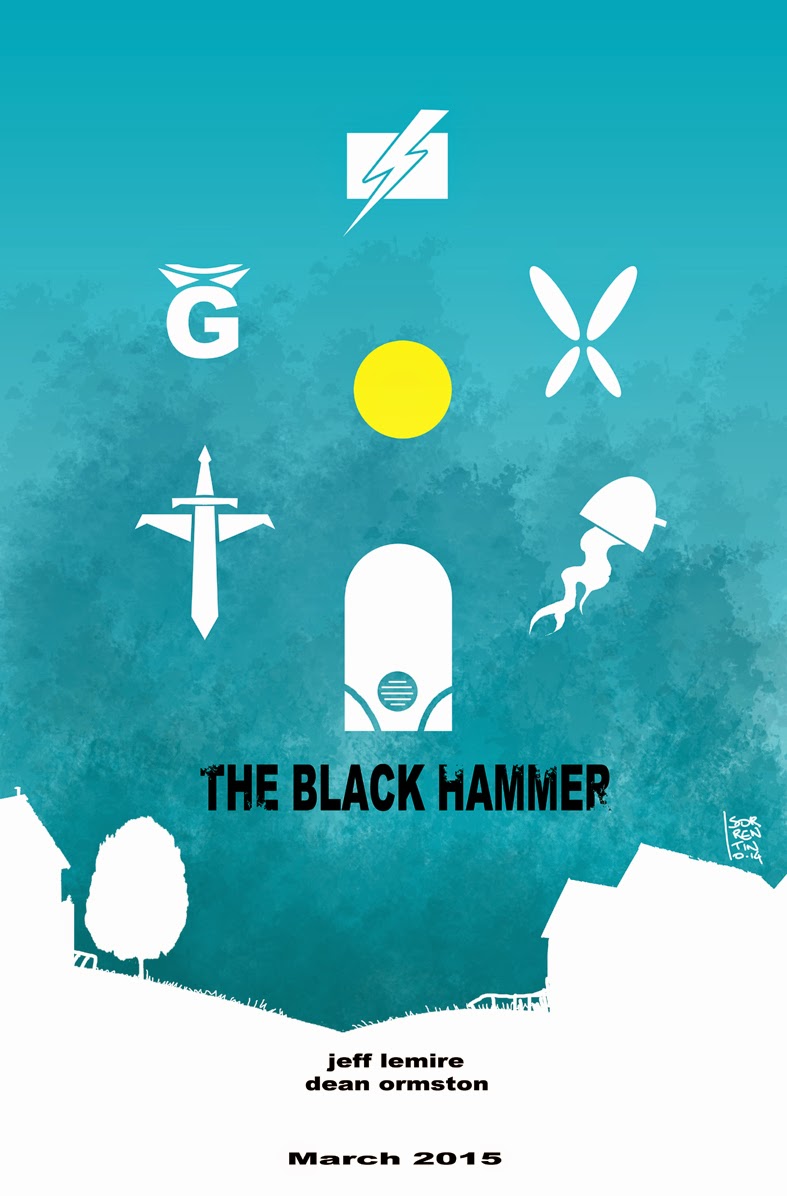 By Kyle Pinion
By Kyle Pinion
In part two of our weekend long discussion with Jeff Lemire, we sat down with him to discuss his newly announced Dark Horse creator-owned title The Black Hammer to find out more about the influences of the title, its potential metaphorical under-pinnings and why he chose to go with Dark Horse for this series specifically.
When you’re getting into a creator owned title like The Black Hammer, I’m sure there’s a sense of freedom due to your direct ownership of the book, but is there a sense of added pressure of finding its audience as well?
I don’t feel a lot of pressure, not really. I just get excited about the idea and want to work on it. I stopped worrying about those kinds of things a long time ago. You just make the books you want to make and people will like it or they won’t. As long as you’re happy with it, who cares?
Why Dark Horse for this particular title? I know you have a new book (Descender) with Image, and all your upcoming work with Valiant. Why was Dark Horse the right publisher for The Black Hammer?
There’s a couple of reasons. I was at DC exclusively for four or five years, coming out of being for only one company for that long, there was certainly a sense of wanting to try new things and wanting to work with different people. Not being locked in with one person or one company again right away. With Dark Horse, one of my best friends is Matt Kindt, and they had done so well with Mind MGMT and Matt was very happy with how that book has been handled so I thought it would be cool to come over and do a book with Matt.
The actual premise of The Black Hammer has been talked about at length elsewhere at a number other sites, so what were some of the influences that led to getting to that point?
Well, the concept itself kinda reveals the influences, its about a group of superheroes who come from every era of comics. And they’ve been wiped out of continuity, and one day they wake up in this small farm and they have no idea why they’re there or how to get back. The influences are all there, you have a different character from each era of comic history that I love. You have a character named “Madame Dragonfly” who is sort of the embodiment of all those great 70’s House of Mystery/House of Secrets horror comics. You can see everything I love growing up is in there, which is kind of mashed with the stuff I normally do in my independent work like in Essex County with a focus on family and small town life. More quiet, character based storytelling. It’s mixing those two things together into something hopefully unique.
Is this the kind of story where the majority of the “super-hero action” takes place in flashback?
I guess you’d call them flashbacks. The bulk of the book is very much their life now, taking place in the small town, ten years after they arrived. They’re trying to live as normal people, a normal family, despite how strange they are and how strange their background is. That’s the bulk of the book, the in-continuity adventures and stuff from their past is just that, they’re vignettes or flashbacks that reveal more about their history and their relationships with one another and things like that.
Is there an ending already in place or planned?
Yeah, I know the ending just like how I knew Sweet Tooth was going to end. I knew the last page of that and I know the last page of this as well. But between the beginning and the end, it’s very fluid. There’s a lot of room to explore different things along the way. So, I know the end-point, but how long the whole series will be, it’s hard to say.
Is it a great amount of fun to write in different character voices from different eras?
Yeah, it’s definitely fun, but there’s also a balance…I had to experiment a bit. When I’m writing something from the 30’s, do I go full-on and try to emulate the writing style completely and go pastiche or do you adapt the sensibilities of that with a more modern voice? I just tried to find a balance there.
Is there any metaphorical material that you’re looking to mine into, ala Kingdom Come?
There is that, but I don’t really want to talk about it…it’s not a spoiler thing, but my thoughts and feelings on superhero comics will probably become pretty clear by the end of this, so we’ll just leave it at that. There’s stuff I love and stuff I don’t, I have opinions. There’s certainly a commentary about the state of the industry. It’s pretty blatant. But also, I have a love that stuff, for all of comics history, and I think this is a pretty sincere love letter to comics as well. It’s not just satire or commentary, it’s me kind of trying to show all the stuff I used to love to read.
You’ve had this idea for quite some time right?
It’s funny, this project has been gestating longer than anything I’ve ever done. I finished Essex County and I started working on this. You’ll be able to see the influence of Essex County in it right away, it very much is Essex County but with super-heroes. I’m not ashamed to say, that’s pretty fun to write. So that was about 2007-2008 when I started working on it, and I was going to draw it as a graphic novel. Then I started to work with Vertigo and DC and my career kind of took off doing other things like Sweet Tooth, and now I’m working on new things that I’m drawing myself. So, it just became obvious that this was something that I really wanted to do, but that I wouldn’t have time to draw the whole thing myself and that was part of the decision to come to Dark Horse and find an artist like Dean.
What does Dean bring to the book that is different from what you would have done had you drawn it yourself?
It’s very different, I met Dean at Thought Bubble, a festival in the UK, about two, maybe three years ago. But I had known his work before that, I followed his work at Vertigo and was a fan. I really admired his stuff, I felt it was very graphic, very bold style. He also has a sense of strangeness, like he can draw monsters, but with a strange humanity to them. I thought it would be interesting to filter superheroes through that strange dark voice that he has, I knew it would be unique and that it wouldn’t look like a normal super-hero comic. It would look like a strange super-hero comic. It can’t just be a thing I’m emulating, it needs its own voice for sure.
When we see the flashbacks, will different styles emerge?
We’re still very much in the process of deciding how far we go with that. How do we use color? Does he completely alter his drawing style for each era? So those are the creative things we’re sort of in the process of working out. I’m not sure what the answer is yet, as I’ve written two scripts and he’s still in the design stage. We’ll see how it plays out.
Having spent so much time at DC under your exclusive, you’re now spread amongst several different universes per se, is that an overwhelming feeling at all?
It’s fun, I love DC. I grew up reading DC and I have nothing bad to say about my time there. They treated me really great. There’s stuff I’m proud of and stuff I’m not so proud of. That just comes with doing a lot of stuff. It’s cool to play in new playgrounds like the Valiant stuff with new characters and a much smaller universe that I wasn’t familiar with. It’s brand new to me, so that’s fun. And, with this book, I’m creating my own comic book universe that is a combination of my own sensibilities and pulling things from history. It’s not so much overwhelming as it is fun. It’s fun to have fresh starts, new people to work with and new things to play with.
And The Black Hammer is coming in February 2015?
I believe March.
Blog: PW -The Beat (Login to Add to MyJacketFlap)
JacketFlap tags: Interview, Interviews, Comics, Breaking News, Michael Cho, Top News, SDCC '14, Add a tag
by Zachary Clemente
Michael Cho is an illustrator, cartoonist, and writer currently residing in Toronto. He has worked with Marvel, DC, and others. His graphic novel, Shoplifter is out this September from Pantheon Books.
Comics Beat: How much is this story and these sort of emotions at this age [of the character] come from personal experience?
Michael Cho: It’s kind of hard to separate that. I think that almost all fiction is somewhat autobiographical. I didn’t go through this experience – I never worked at an ad agency and I don’t shoplift. But the emotions certainly come from that – part of the story is about being in your mid-20s and feeling like you’re sort of drifting and not going in the direction you want to get to your goals. I’m keenly aware of that because that’s what I felt like in my mid-20s – I was graduated from school, I went to art college, and I had a series of jobs but since I was outside of that structure of school where you’re told what to do, I was aware that what I wanted to do and what I was doing were two different things.
CB: I was under the impression, based on how personal the work feels, that you had worked in advertising before.
MC: No, but I am a freelance illustrator, so I’ve worked in and done assignments for advertising; and I know someone close to me who worked at an ad agency and a little bit of my inside knowledge of working in an agency comes from that. He went into the ad agency with the best of intentions and then when there was an economic downturn, their next account was cigarettes. I thought then “okay – this happens.”
CB: One of the things about Shoplifter I loved was your perspective on people in a city and your representation of advertisement in a city. Do you feel that comes from wanting to show ads as a large part of city life?
MC: Yeah, I think advertisement is ubiquitous and part of the theme of the book is the impact or influence of advertising in subtle and not so subtle ways. Whether it’s through social media or through [physical] ads, I was keenly aware when drawing it that I wanted to depict the advertising that permeates the city. Bus shelters, on the street, TV commercials – things like that; I wanted those things to be represented and be fully surrounding you at all times, so that was important for me to convey. Also, the city itself […] to be something of a character in the book; I wanted that city to be not just a background for the figures, but also to have scenes where the city itself is the character.
CB: Based on bits and pieces in the book and where you’re from, is this city Toronto?
MC: It’s based on Toronto because it’s grounded in what I know and it’s not a made-up world; Toronto is my hometown, so I tend to draw that. But it’s not actually Toronto – for instance the drawings of the subways are not Toronto subways.
CB: Those seem very New York.
MC: Yeah, they’re actually subways from Brooklyn. What it was for me is that it’s not meant to be a specific place; I never named the city – it’s meant to be any large city that that people gravitate to from smaller towns.
CB: The only way I could piece it together was during the airplane scene on TV – where the flight was coming from.
MC: That was a real event, actually. One of the reasons I included that was that I was watching broadcast coverage of an air crash that didn’t happen – it unfolded very much like it did in Shoplifter, I just changed a few bits around, but when I was watching it, all I could think was “Wow, this station really wants a disaster to happen.” Canadian media is always a little behind American media in the way it tries to sensationalize things, but in that case is it was one of those moments, and it was one of those things that had some parallels to the story.
CB: I got a sort of black and white depiction of social media in certain respects of our daily lives-
MC: In what way?
CB: Specifically in the club scene, there was a guy talking about how connected he is 24/7 and I feel that recently this is a very prevalent discussion – whether how social media affects us is “good or bad” and I feel a couple of the scenes spoke to me trying to say one or the other, but in the end I feel it said both.
MC: I definitely wasn’t trying to depict it as “bad” because I don’t think social media is bad, but I do think it has an impact and subtly influences the way we live our lives. There is a scene in there where one of the characters, says that as a result of social media, people are doing to their own lives what advertising does with products; they’re actually being pitchmen and marketers of their own lives, but that isn’t necessarily a negative. What I was trying to point out was that while we feel more connected to people, more than ever, there are moments where we are isolated, despite all this, and for all the connectivity we get – daily updates and awareness of others – people can still slip through the cracks and different kinds of walls get put up.
Vice versa, to flip that, with people whom we might not have any connection with at all, there might be surprising connections that we may not be aware of that exist – and that’s a part of Shoplifter.
CB: That’s very thoughtful. I feel those themes were successful, considering I brought my own notions of social media and how it’s treating in fiction to the work.
MC: Yeah, I wasn’t trying to show it as negative in anyway because I don’t think you can say that about any communication medium. It’s the communication itself that may be positive or negative – but the medium itself is neutral. It’s like saying movies are bad because this one movie sucked. That’s ridiculous – you can’t blame the film stock or the process for that.
CB: This is your first full sequential story to come out?
MC: Sort of. I’ve done shorter stories – I kind of straddle all aspects of comics. I’ve drawn mainstream comic stories for Marvel and smart art jobs for DC. Chip [Kidd] and I did a nice Batman: Black & White story featuring Batman and Superman and I’ve also painted covers. I’ve also written and illustrated shorter comic pieces of my own that are sort of similar to Shoplifter in the sense that they’re just fiction – not genre-based at all and I used to put out a webcomic once a month which started out pretty short but got bigger as I got more confident at it; going from an 4-page story, to an 8-page story, to 16-page story; and I’ve had those types of stories published in some unusual places. They’ve appeared in literary magazines in Canada, and Houghton-Mifflin put out an annual anthology called The Best American Comics for which I did a story about the making of the atomic bomb which was picked by Neil Gaiman for the 2010 edition. So I’ve drawn other comics, it’s just that they’ve been outside mainstream channels.
CB: Do you see Shoplifter as your entrance into a different part of your career – a different stage?
MC: I knew for a long time that I wanted to write and draw my own comics and graphic novels of the kind that influenced me when I was younger. In my teens, for example, when I felt like I was starting to drift away from comics, I discovered the Hernandez brothers [Jaime and Gilbert] and all the comics that came out from Fantagraphics in that era and I realized there was more to comics than I had originally thought. It opened up my mind to the idea of comics as a medium, not a genre. In some ways, I knew then that the comics I would write and draw would just be fiction and any stories I had intended to just write as prose could be comics instead.
Years later, when I was a freelance illustrator, I still knew that’s I wanted to go eventually. I wanted to be able to sign my name on a cover knowing that it was something I did completely from beginning to end myself. I set about putting together a few outlines of graphic novels I wanted to do, while also doing shorter stories, and Shoplifter was the first. There’s five somewhat interconnected stories that I want to work on as graphic novels over the next few years.
CB: Out of personal interest, when did you move from Korea?
MC: Oh, I moved here when I was about six and a half. I didn’t go to school in Korea, so my Korean is very poor; my mom and dad think I speak way better now just because I’ve started using the politeness terms. Are you Korean?
CB: On my mom’s side, yeah. She moved when she was 16 and has very fond memories of hanging out in little shops, reading until very late at night, when her father would pick her up, very upset.
MC: My vivid memories of Korea are drawing, giant robots mostly. In that era, there wasn’t much TV – it was all 6PM to 11PM, stuff like that. Since then it’s boomed and Korea’s now the high-tech capital of the world or something. I have very fond memories of that but I just never went to school there, so in some ways, English is kind of my first language. I’m in that 1.5 generation or whatever they call it.
I grew up in a town where there wasn’t as large an Asian community as Toronto, so I cultivated an “outsider” viewpoint on things and it’s been really helpful to me and I would never trade it for the world. It’s like there’s a Korean side of me and a Canadian side of me and I can relate to both, letting me see different sides of an issue; I’m very happy I have that ability.
CB: Thank you very much, Michael.
MC: Thank you.
Blog: PW -The Beat (Login to Add to MyJacketFlap)
JacketFlap tags: Legal Matters, Cosplay, Top News, SDCC '14, Add a tag

I’m sure everyone has now read up on the details of the arrest regarding the 17-year-old cosplayed who was found injured and was presumably attacked at Comic-Con on Saturday night. The man who was arrested was 29-year-old Justin Kailor, a photographer associated with something called Project Cosplay. Kailor was friends with the victim, and indeed many photos of her are watermarked with Project Cosplay so she clearly had an ongoing relationship with the project. According to Kailor, the two went to the show together and argued at the Marriott about whether to leave or not, and he became worried when she left. About an hour later she was found bloody and unconscious at the pool or the Marina Marriott.
“I just wanted to call it a night and take her home to her parents and be on my way…,” he said. “She ran off and I didn’t follow. She didn’t answer the phone. She was gone for so long I asked security if they had seen her.”
About an hour later, he said, security found the girl unconscious and bloodied in the hotel’s pool area. He added he was with security when they heard she had been discovered and police were notified. The hotel manager did not return calls seeking comment.
THe girl’s family was interviewed by local news, and confirmed that the victim would have a long recovery, but the support of the cosplay community was much appreciated. Police haven’t commented on whether Kailor is involved in the assault on the victim; his arrest was in connection with giving her alcohol and unspecified “sexual contact” with a minor.
The investigation is still ongoing; anyone who has any information should contact [email protected].
A few personal comments: it’s hard to imagine an idea more disturbing than a bloody, severely injured teen-aged cosplayed being found by a pool at the Marriott Marquis, possibly sexually assaulted, in the middle of Saturday night at Comic-Con. I’ve been by that pool, you’ve been by that pool. I took a shortcut through that pool nearly every day at the con. I stayed at the Marriott on Tuesday night, I’ve been there with groups, I’ve been there alone and so have you.
There is a great deal we do not know about this case, and I’m not going to speculate on what happened. But based on what we do know, there is nothing shocking, unusual or dangerous about the behavior of the victim. She did what hundreds and thousands of people have done at Comic-Con for years—dressed up, hung out with friends and moved around a place she assumed was safe.
What is shocking, unusual and dangerous is the behavior of whoever left her lying bloody by the pool.
I’m turning off comments here, but if anyone has any RELEVANT information regarding this, such as benefits, cosplay group response, or knowledgable insights, email me at comicsbeat @gmail.com. This is obviously a tragedy, and will contribute to a lot of the ongoing discussion about cosplay, consent and conventions.
Please continue to think good thoughts for this young woman and her family.
Blog: PW -The Beat (Login to Add to MyJacketFlap)
JacketFlap tags: Dark Horse, Breaking News, Top News, SDCC '14, The Fifth Beatle, Vivek Tiwary, Add a tag
 By: Kyle Pinion
By: Kyle Pinion
Vivek J. Tiwary is a multiple award winning Broadway Producer whose productions have netted 25 Tony Awards and 44 Tony nominations. The culmination of decades of research, The Fifth Beatle, his graphic novel telling the tale of Brian Epstein, the man who discovered and managed The Beatles was released in November of last year. As of this past Friday, Tiwary is also an Eisner Award Winner as The Fifth Beatle won the award for “Best Reality Based Work”.
Just prior to this win, I had a chance to sit down with Tiwary and discuss this stunning graphic novel and some of the background behind it.
When did you first hear the name Brian Epstein?
I’m a life-long Beatles fan. My parents introduced me to the Beatles. My parents always say that I was listening to the Beatles before I was born, because my mom was listening to them when she was pregnant. I’ve always been a bit of a nerdy guy, a bit of an academic…following history, and in terms of comics, I’d get into creators. Who were the artists? The inkers? And similarly with bands, I’d get very involved in who signed them and who their managers were. I probably heard his name 30 years ago, but it was 20 years ago when I was in business school in Philadelphia that I decided to learn something about the guy. I realized that The Beatles and Brian were the team that wrote and re-wrote the rules of the pop music business, but I didn’t know anything about him. So it was about 20 years ago that I really said “Who is this Brian Epstein character that I heard who managed and discovered the band?”
I understand you spent 20 years in research for the project. What did that research entail?
Starting this project 20 years ago, if you put that in perspective; during that time, there’s no Wikipedia, no YouTube, no Google. There are none of these online resources that we take for granted today, and there are no books about Brian Epstein. The Fifth Beatle is the only book in print, graphic novel or otherwise, about Brian. So 21 years ago, I didn’t have any choice but to do interviews. I had basically read all of the respected Beatles books and slowly I put together a portrait of the people that knew Brian best. And then I just cold-called these people, and they were not the celebrity names. Certainly there are people like (Paul) McCartney and Ringo Starr who obviously knew Brian, but Brian’s management style was to shield the band from his struggles. There’s a line in the book: “You focus on your music, and I will play the business like my instrument, and you will never have to hear it.” The people who knew Brian best, like Nat Weiss, who is in the book, was his best friend and the Beatles’ US attorney. Sid Bernstein, who is not in the book by character, but his spirit is in the book, was the Jewish concert promoter who brought the Beatles over to the United States for the first time. And he and Brian shared some of the same struggles of being Jewish men hustling in the music industry in the 1960’s. It’s a bit strange to think of this now, but in that time, there wasn’t an extensive number of Jewish people in that industry, especially not in the United Kingdom where the industry was run by Lou Gray and Sir Joseph Lockwood – these older, white Christian Knights of the British Empire. It wasn’t run by individuals with names like Epstein. So literally I just figured out who were the people who knew Brian best, and I cold-called them. I focused on the people who were within driving distance, like Nat and Sid who were both New Yorkers, and I just said “Hey, I’m a young person, looking for more inspiration and I got inspired by the little bit I know about Brian, would you talk to me?” And I will be honest, I was so excited about reaching out to these people that I forgot to be intimidated, and not one of them turned me down. That’s how I began my research. Obviously it expanded from just the people who were nearby. I wound up talking to Joanne Newfield, who is now Joanne Peterson. She was Brian Epstein’s personal assistant, and she was literally there with him the day he died. So, she was a great reference to me, while living in Australia now. That’s how I did my research, with people living all over the globe.
Did sources ever conflict in their accounts of Brian at all?
All the time. This is one of the challenges that any biographer faces, but certainly one for anyone that is working on a Beatles-related project and for someone who is as little known as Brian. There were people who said “Brian would never do that” and someone else would say “Brian totally did that.” Even little things, like when I presented the book to some people, they would say “Brian would never call his mother ‘Mommy,’” with others knowing him very well saying that he was very close with his mom and would absolutely do that. So who do you believe? As a biographer, you have to do all the research that you can, and you either go with the person that you think is the most reliable on that issue, or you interview five people and if three of them say it’s one way, you have to go with the majority. Those are the two decisions you make. But at the end of the day, that’s the role of the biographer. You have to go with what you think is the truth.
When did Andrew Robinson come into the picture?
Like I said, it was about 20 years ago that I started researching the subject. It was about ten years ago that I decided that I wanted to write a graphic novel, and that started with scripting and figuring out how I wanted to tell the book. It was about five or six years ago that I was looking for an artist. I was making the book independently at first, before Dark Horse was involved, and I hired a gentleman named Mark Irwin, who was the book’s first editor and a very accomplished inker in his own right. But in his role for me he was working as an independent editor, helping me with my script and helping me to find an artist. He was working with Andrew at the time, and Andrew was one of the very first people that Mark recommended. I knew Andrew as a comic geek. I knew he was an amazing artist, and I knew he could certainly do the job and do it beautifully. But it was really when I sat down with Andrew and started talking to him that I realized that he was perfect. It was important for me, because it was my first graphic novel, and partially because I come from theater, which is a collaborative field. So working very closely with the artist was something that I wanted. It was clear that Andrew and I were going to have that kind of relationship. He also was a huge Beatles fan but understood that this was Brian’s story, and it was the human element of Brian’s story that really appealed to Andrew. To me, that was critical in the storytelling of The Fifth Beatle.
In relation to your theater background, how would you liken your role and Andrew’s role to the traditional ones seen in film and on stage?
If you’re looking at as a film, then I suppose I am both the writer and the director, and Andrew is the cinematographer, and the art department, and a bit of the music director as well. Much like a film, we really collaborated on everything. There were pages of my script where I was very specific. I knew in my head that I want four panels here, and I want one panel to look like this and a camera angle to be this. There were entire sequences where I said here is what the characters are going through and here is how they feel, here is what is emotionally happening and here is the dialogue, but I have no idea how to do this. Andrew would then come back to me with it all laid out. We really did both. There are some comic writers who are very particular and want things exactly this way, and there are some that have no idea and just provide dialogue, and I guess I’m a bit of both. There were some scenes where I was very meticulous, down to photo references, and then there were others where I wanted Andrew to have mastery over it.
I can’t imagine the feeling you must have had when you saw the finished product.
Oh my gosh, I remember the experience I had when I saw Andrew’s first page, which was page one, the Liverpool panorama, and it was like my heart literally skipped a beat. It was watching my dreams visually come to life. It was amazing.
How would you define the relationship that Brian had with John vs. the one he had with Paul?
Obviously, Brian’s relationship with John is deep and complex. John was the leader of the group when Brian started working with The Beatles, and by the end of their career as a band, John and Paul were both taking leadership roles. But in the beginning, there was no question that it was John’s band. So, Brian really did start working closely with John, because he was making a lot of the big decisions. A lot has been made about Brian and John and whether they had a romantic relationship, and there’s no question in my mind that Brian was attracted to all of The Beatles, in particular to John. But as you’ll see, the way I handled that in the book – I think that John teased him somewhat mercilessly as John I think was wont to do. John was one of these guys that had a very acerbic wit, and he put his friends through the ringer. To hang with John Lennon, you had to earn your stripes. So I really think there was a lot of love between the two of them, a lot of genuine love, but I don’t think it was a romantic love. If anything for Brian, it bordered on the love a father has for a child, in a lot of ways. I think Brian viewed the Beatles as the children, as a gay man, he would never have. A gay man in the 1960’s where it was illegal to be gay, forget about getting married and adopting. Brian was very paternal with The Beatles. There was a friendship there that was emotional and familial. I think Brian’s relationship with Paul was a little more business-oriented. Paul was more about the numbers, the image and the marketing than John was, and certainly at the end of the book there’s a scene where a number of people visit Brian on his death bed and he had these hallucinatory moments, Paul is one of the people that shows up. Obviously that’s a fantasy, that’s my creative license as an author, but you’ll see in that sequence they talk a lot about the business. Brian says “you’re the one that’s going to be in charge of the legacy,” because he knew that Paul was going to be the person that was going to take charge of the legacy most seriously from a business perspective. Not that John wasn’t proud of the legacy as the founder of The Beatles, and as a key member, but Paul is really the one that understood it from a business stand-point: The books, the greatest hits records, the preserving of the band historically, that’s a Paul thing and was also a Brian thing as well. Brian’s relationship with Paul had a more archival aspect if that makes sense, the caring about and the creation of history.
John also had other interests brewing at that time as well, with Yoko coming into the picture or about to do so.
Lennon once said “there were only two people in his entire life that he would listen to and do whatever they told him and that was Brian and Yoko.” And Yoko really comes into the picture where Brian left off, and John even says this, she filled an almost paternal void that he felt when Brian left. John sometimes needed somebody to tell him what the fuck to do. That’s not to say Yoko and Brian were similar. There was just a part of their relationship with John that was.
For those who have read the book, this has been a question that’s bantered back and forth a bit, how open to interpretation is the existence of Moxie?
Very! I will go on and let you decide how much to print because I do like the fact that you walk out of the book with the ability to debate that subject. That was the point. I want readers to not be sure about this. That being said, there was no real person named Moxie, however everything Moxie does was done by four assistants. She is most closely based on Joanne Peterson, who I mentioned earlier, who was Brian’s personal assistant, she was there when Brian died. She will readily say she had an innocent crush on Brian. She didn’t romantically chase him, but he was older, intelligent, well-dressed and debonair. He was everything that a man should be in her teenage eyes. She loved Brian in that sense in the way that Moxie does. Moxie is also one-part Wendy Hanson, who was another female assistant Brian had. She’s also one part Alistair Taylor, who was the assistant that first took Brian to The Cavern Club in 1961, which Moxie does in the book. She’s also one part Peter Brown, who worked very closely with Brian and very closely with The Beatles afterwards. So if I had to answer the question very specifically, she’s a conflation of four real-life people. I also wanted Moxie to be a little bit of Brian’s head. She’s Brian’s “moxie”, his ambition, his drive. She’s a lot of different things, so I hope her existence does cause some debate amongst fans of The Fifth Beatle and Beatles fans. While it doesn’t take more than a Google search to know that there was no real-life Moxie, everything she did is based on history. Brian took Joanne Peterson to a ball and ballroom danced with her. She said it was one of the best nights of her life. But JoAnne is not Moxie…at the end of the day, she’s my creation and I think she represents Brian’s ambition in life.
But Dizz is real though?
Dizz is very real unfortunately. There was a gentleman in real life named John Gillespie, people nicknamed him “Dizz”. He blackmailed Brian; he was a hustler. He flew to the UK and blackmailed Brian in public. Since we’re getting specific, I will say I made up the television interview. He did blackmail Brian in public, but it was at a party, not on television. Dizz was unfortunately a very real person.
Any future projects that we can get excited about?
There’s a few things that I have cooking that I can’t quite talk about, but I’m working with Alanis Morrisette, and we’re adapting her album Jagged Little Pill for the stage. We’re turning it into that into a Broadway Musical. I’m incredibly excited about that. I expect we’ll be able to announce our writer within the next few months. Tom Kitt is already attached to compose orchestrations and arrangements, which Tom did for me on American Idiot, of which I was a producer, and he’s a genius. He’s a Pulitzer and Tony winner for Next to Normal, so he’s amazing. That’s probably the key thing that people can get excited about. Right here at San Diego Comic Con, I wrote a short story for Harbinger Issue 25, their anniversary issue. It’s out and here at the convention. Gilbert Hernandez, the wonderful Gilbert Hernandez drew an exclusive cover for Harbinger and it’s a benefit for the CBLDF (Comic Book Legal Defense Fund), and we’ll be doing a signing here at the show. This is a dream come true, the man is a genius, to say that Julio’s Day was one of my inspirations for The Fifth Beatle would be an understatement, and I’m thrilled to be working with him. Harbinger 25 is out now, it’s in stores, and I’m very proud of the story I wrote for that. There’s certainly The Fifth Beatle film as well, which we’re in active development on. We’re in the casting process, and we’re on track to shoot next year.
Is Peyton Reed still attached to direct?
Now that Peyton is attached to Ant-Man, scheduling has become a bit of a tricky thing. Peyton loves The Fifth Beatle, we love Peyton, but we’ll have to see how the schedule plays itself out.
Blog: PW -The Beat (Login to Add to MyJacketFlap)
JacketFlap tags: Top News, SDCC '14, Add a tag
By Victor Van Scoit
I planned on writing journal updates based on my daily experiences, but the time vortex that is San Diego Comic Con always wins at some point. With its voracious appetite it eats up every second of time that isn’t reserved for basic human survival – like sleep and sustenance – and even those begin to suffer. But I have time now to look back not only over the past few days, but the past ten years of attending San Diego Comic Con.
THE CONVENTION FLOOR
I was surprised that by Thursday afternoon I felt like I’d seen all ten football fields worth of pop culture goodness on the convention floor. Any additional time I spent was focused on Artist’s Alley and chasing down the final issues of Locke & Key. The former involving great conversations and artistic discoveries. The latter left me empty handed and proving that SDCC was no longer suited for back issue digging, and I would have to go to a smaller convention to experience the thrill of the hunt to fill in my collection.
The expectations of acquiring SDCC Exclusive merchandise remained in high gear. Hasbro was king with the biggest draw and people camping overnight, while Funko and Super7 had fervent demands for their toys as well. Publishers also pushed their exclusives often in combo with creator autograph sessions yet in both cases (toys and comics) the lines were in control.
In speaking with seasoned attendees there was a sense that while crowd size grew day-to-day the floor felt less packed and more maneuverable than in prior years. The Warner Brothers booth still drew large crowds for celebrity signings for the casts of Game of Thrones, The Hobbit and the like, but gone were the spectacle booths, holy grail giveaways, and additional celebrity signings that often caused traffic bottlenecks. Considering SDCC sold out of attendee tickets this year again, I was curious where all the people were especially since the number of off site ventures had decreased as well.
OFF SITE ACTIVITIES
The new mainstays were still there like Geek & Sundry Lounge, Nerd HQ, and PetCo Park’s Interactive Zone whose main draw is Adult Swim. Geek & Sundry served its niche audience well with activities like board games, video game demos, and panels featuring talent from their YouTube shows that kept attendees engaged and sticking around for their evening parties. PetCo Park’s Interactive Zone and the park near the Hilton Bayfront had brands that drew people in for a carnival like atmosphere. Nerd HQ continued to offer its Conversations for a Cause and celebrity photo opportunities but didn’t have as many offerings as last year that would keep attendees around, though they did throw a fun Thursday night dance party. Such as it was, there was a decrease in off sites that contributed to the sense that Comic Con wasn’t in crazy showbiz mode.
The decrease in Hollywood studio presence and other big branding attempts was definitely noticed. There were only a couple of hotels wrapped with ads for upcoming TV shows, and the number of parties and interactive branding spaces were small compared to years prior where there were 3-5 times as many. Consider that in 2011 when Trickster, the creator driven alterna-convention, was located in the wine bar across from the convention center. Each subsequent year they were pushed farther away from the convention center due to rising event space costs and the companies that could pay them. That same wine bar from 2011 remained unbranded and relatively empty all convention long. Rumors of greed had event space owners asking for five times more in 2014 for the same space in 2013. Mix in Hollywood being more cautious after not gaining returns on SDCC darlings like Scott Pilgrim and Cowboys and Aliens, one can speculate as to the diminishing presence.
LINES and PROGRAMMING
That’s not to say studios weren’t represented well in the lines for panels in Hall H, Ballroom 20, and the Indigo Ballroom. Attendees were quick to pull out the sleeping bags, pillows, and lawn chairs for their overnight stays so that they could gain a seat. Even the wristband mechanism that was implemented for Hall H this year seemed to help the organization. But once again it was curious to see how things had changed from what may very well be the peak of last year.
While all weekend long each of the big rooms had long overnight lines, once the rooms opened up the dynamic changed across each. Ballroom 20 would fill in for its first panel of the day and then the line hardly ever extended outside again. You could actually show up for the panel you wanted as much as an hour in advance and sometimes as little as five minutes and get your seat. Indigo Ballroom’s line remained strong compared to prior years but it benefited from better programming, yet suffered since it had less seats to offer than Ballroom 20. Such was the case Friday when I arrived at 4PM to check out both the Bob’s Burgers and Archer panels. The folks at the front of the line had been in line for four hours and were finally going to get in. These were two shows that would’ve been better suited in Ballroom 20 rather than, say, the world premiere of unknown pilot Scorpion. Perhaps we’re at a sea change where there’s not as many cultural phenomenon shows out there as there once was.
Hall H also showed how programming would affect it. I almost felt guilty being able to walk into a panel on Thursday in Hall H without having camped the night before. The only reason Hall H filled up on Thursday at one point was because Twitter notified everyone of Matthew McConaughey and Christopher Nolan’s presence. The Interstellar trailer wouldn’t be far behind and that sent everyone running. Hall H then came back in full force on Friday and Saturday with stronger programming and concluding with its usual Marvel Studios high come Saturday night. Marvel Studios still remains the Hall H crown jewel for popular culture fan as they displayed once again what other panels lacked – showmanship and hype. Just before the Marvel panel started at 5:30PM I spoke with those around me and they had only just gotten inside having been in line since 11PM the night before. That’s the harsh mistress I know the Hall H line to be.
WHAT A DIFFERENCE TEN YEARS MAKES
My first San Diego Comic Con I thought to myself, “They were right. This is big. This is way big.” The Hollywood dollars changed the game and many proclaimed SDCC was too big, overexposed, and couldn’t possibly get bigger. I thought I missed the boat to visit back when the convention was small. Each year it seemed as if something new was added like brand experiences in parking lots, video game companies participating, every hotel being wrapped in giant movie and TV posters. Hell, the Hilton Bayfront hadn’t even been built. Now I can’t even imagine San Diego Comic Con without the Indigo Ballroom or the Hilton’s Odysea Bar where I’ve met many creators and talented directors and actors. Little did I know that years later I would look back and think “My first year was tiny compared to all this.”
That first year I was helping to make HD quality video blogs for DivX’s content network. The company needed someone who understood the comic book landscape to host video segments. Back then there were no iPhones, small HD cameras, and Facebook and YouTube were nascent companies. So with high quality cameras the team would hit the floor each day looking for interviews and cool items I could point out to show exactly why comic books, pop culture, and this convention was great. It’s funny to think that there were probably only twenty similar camera crews on the floor back then. Whereas now it feels like the floor is swarming with camera crews and their portable devices, trying to record interviews and bits for their YouTube channel. You also better have industry contacts because those press and professional badges don’t go as far they used to.
Ten years also gave me the perspective to notice what I’ve alluded to earlier, which is that San Diego Comic Con just didn’t seem that crazy. I used to to enjoy walking from my hotel near Broadway down to the convention center so I could see all the brand take overs. And yet this year there wasn’t much of any pop culture interest until one would hit the area near the Hard Rock Hotel. My panel schedule of the day is typically filled with plan A, B, C, and D knowing I might not get into my first choice due to crowds. And yet this year the only reason I had to go to my second choice was due to mood and not capacity being reached in a room. While attendance for Comic Con 2014 didn’t go down the looming presence of the entertainment industry certainly did. Frankly this was the first San Diego Comic Con where I felt paced, I had time to meet with various friends, and got to do 95% of what I wanted to do. Did the entertainment money bubble burst and are we in for a few years of a normalized landscape? Is the Comic Con audience now so broad that studios and brands aren’t getting the discerning looks and cultural penetration they once were? I’ll be curious to see, and if I’m lucky I’ll get another ten years to find out.
Blog: PW -The Beat (Login to Add to MyJacketFlap)
JacketFlap tags: Comics, Conventions, Breaking News, Valiant, Joshua Dysart, Robert Venditti, Top News, Top Comics, Matt Kindt, SDCC '14, Warren Simons, Matt Kindt. Clayton Crain, Valiant Comics, Add a tag
By Alexander Jones

Valiant is an incredibly dynamic and interesting superhero publisher that isn’t afraid to take risk after risk with their properties. Comics Beat had the opportunity to sit down with some of the brightest minds working at the comics company including Joshua Dysart (Harbinger: Armor Hunters & Harbinger: Omegas), Robert Venditti (X-O Manowar & Armor Hunters), Matt Kindt (Unity, Rai, & The Valiant), & Valiant Editor-in-Chief Warren Simons.
Comics Beat: The Valiant Universe is in a big place of transition right now with Armor Hunters. How do each of you manage to keep the tone of your own books, while still involving the individual characters in the event space? For instance, Harbinger still feels like Harbinger with or without Armor Hunters.
Joshua Dysart: I mean I just don’t read Rob’s scripts. It allows me to really keep my tone [laughs].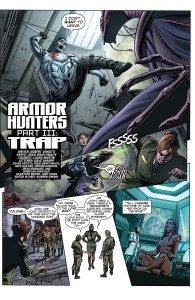
Warren Simons: They’re too intimidating for him.
Robert Venditti: You will paralyze in fear if you read my scripts.
Dysart: No, I actually think it’s because we all work together. We have a central vision and editorial team. I think that we are all valued for our voices and effort that we put in towards making these titles unique.
Venditti: It was never about we’re going to do this story, and he’s going to have to be in it. We’re going to do a story in other ways that your books are going to tie in and if so, what are your ways and let’s talk about them.
Dysart: Yeah, and you know when Rob and Warren came to me, they didn’t come to me with anything that I had to do. They were like ‘these are the parameters we have to keep in places, and there are some pieces in play here that are interesting’. That helps a lot, that’s a great way to work.
Venditti: When we came up with the premise for Armor Hunters, we were curious how these books were going to react to each other.
Dysart: And, I think that the truth of the matter is that conceivably, it would be exhausting to us and it would stretch the marketplace; but we have such a tightly integrated universe right now. We could conceivably make every storyline a crossover–it would be exhausting and terrible. I think our books could easily respond to each other right now in that way without it being forced.
Simons: I think that I have tried to make sure that the guys are all in clear and close contact with each other about what’s coming up. Rob just did a great job on the Armor Hunters: Aftermath issue, and that’s going to have and that’s going to cross into what’s happening with the Unity team. We want to make sure that nobody is stepping on one another’s toes. So that as Josh said, we are preserving their voice that we hired them for instead of forcing everyone to write a certain way.
Comics Beat: The next thing that I wanted to do was try to get a question for each of you. Rob I want to know with Armor Hunters,is Aric’s empire crippling? Or, is his time with the Visigoth people is coming to an end, or perhaps, is there a status quo shift coming up for the book? 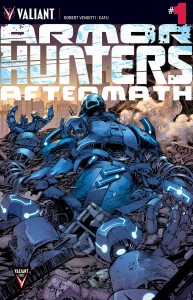
Venditti: Yeah, I mean I think we have done status quo shifts almost every four issues since the series started. It’s something we have always tried to do. As far as him being a leader of the Visigoth people, when he came back with Rome, they got hit pretty badly after that fight–this is very long form story that we started with from the first issue. He comes from a group of about 40,000 people that were traveling around Europe. As he travels back to Earth with a suit of armor in the modern day and see’s what the world has become now, I think we start to see Aric evolve as a character that bears witness to the planet in a much different way now. The transition from him as being the leader of a small group of people to him being a leader of the globe. This is a global community now. Even the idea of the globe is a concept that is completely foreign to him.
Comic Beat: Now, Warren, as Valiant’s Editor-in-Chief, have your tasks changed at all?
Simons: A little bit. The company is growing, we are expanding. We just hired another Editor, Kyle Andrukiewicz.
Simons: Everything is heading in the right direction. I am still going to continue to edit and work on the books with the guys. Josh Johnson is an Editor up there working on Archer & Armstrong and The Delinquents. Associate Editor Alejandro Arbona is working on The Death-Defying Dr. Mirage, he’s just killing it, and he’s working on a bunch of other titles as well. We’re getting bigger, but I am continuing to edit many of the books that we are putting out.
Comics Beat: We just saw Bloodshot join Unity, how is that going to affect the greater team?
Kindt: Not that much really, we just have a killing machine on the team now. He’s going to come in handy I think at the end. I thought the interesting thing about having him join the ranks, was seeing his interactions with Livewire. Especially when keeping in mind the fact that she can talk to machines. She is the only person that can really stand up to X-O. Livewire can take control of his armor as well. This is especially interesting when keeping in mind that Bloodshot is a machine. Seeing them interact is going to make the comic engaging. They have tonal similarities as well. Livewire is continuing to question his humanity. Even though they are opposite in many ways, they have a lot of similarities.
Simons: The first eleven pages of Unity #10 are absolutely awesome. It’s extraordinary stuff!
Comics Beat: One of the things that I wanted to clarify for your books….
Dysart: And for Josh, I needed some clarification!
Comics Beat: So we have Armor Hunters: Harbinger, but how does it line-up with the Harbinger title proper, and Harbinger: Omegas coming up?
Dysart: The Armor Hunters: Harbinger book is primarily for the Generation Zero kids. If anyone is caught up on Harbinger, they moved from being lifelong prisoners of rising spirit to being prisoner to Harada, Now they are free. They are the protagonists of the Armor Hunters series. Their last big moment in the sun was Harbinger Wars, our last big crossover. Omegas is predominantly concerned with and Harada not necessarily that they come into contact with each other. Harbinger #25 happened, and these two series are sort of happening at the same time after Harbinger #25.
Comics Beat: After the announcement of the Archer & Armstrong movie, how do all of you feel about the prospect of having these different Valiant characters that may be coming up on screen one day?
Simons: I think it’s great. I think that first and foremost we are a comic book publishing company; and we are really concentrating on the comics themselves and making the books as a good as possible, and not necessarily worrying about whether or not this will play into a movie, or whether or not this particular character will translate to the big screen. As you can probably confirm by reading the first 11 pages of Unity #10. [laughs] That said, I think it’s great. I think it provides us with the opportunity to expose our characters to a wider audience which is always important with a young company like ours.
Comics Beat: What new layers do X-O Manowar #0 and Unity #0 add to the mythology of both books? 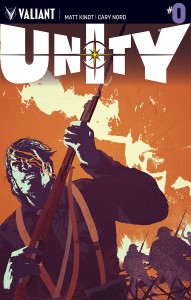
Simons: You should tell them the story. It’s freaking awesome, a little bit of it.
Venditti: In the Armor Hunters X-O Manowar tie-in issues we are seeing the armor from the opponents’ perspective. We’ve gotten a lot of information about the armor recently in the X-O Manowar #0 Issues, I thought it would be a good time to focus on Aric as a character and what his origins were being a Visigoth. Which we got a sense of with X-O Manowar #1 in Rome with 402 A.D. Aric rallies armies behind him and he’s fierce, and he’s killing the Romans like crazy. What was the character like before all of that? We dealt some of that information in the earlier issues of X-O. The idea is that he is just a boy. We were all just kids at some point in our lives. We aren’t born amazing swordsman. The upcoming issue opens with a page one, panel one image of a 16 year old Aric throwing up behind a tree. Then you pull back and see that a huge battle has just taken place. All the Roman bodies are on the ground from the battle. The Visigoths are taken away to be buried, but the Romans are still there. His job, and the job of his friend Gafti, is to kill the mortally wounded Romans and put them out of their misery. Aric is struck by the violence of it, and so horrified, that he is actually throwing up. He doesn’t want his friend to see it. Like he had something bad to eat, but he doesn’t want his friend to see that he’s barfing his guts out. It’s so horrific to him because he wasn’t born as that type of warrior. The book looks at him from that perspective. How do you get tested by battle, and how does this really hard conflict reveal things about you that you didn’t really know were even there–both for him and for Gafti?
Comics Beat: What about Unity #0?
Dysart: It starts with Livewire vomiting behind a tree.
Kindt: She is upset about everything that Aric did. (The room laughs.) Unity #0 is basically the first iteration of a super team set during WW1 lots of great parallels between that team and modern Unity. It’s interesting to see what events would happen to see making a modern Unity team necessary. I think we are going to do something interesting with the beginning and the end. We are going to do some of the inside cover stuff. There is a letter between the President of the United States and the Prime Minister that grounds the story in reality and sort of shows the politics behind getting this team together. There is also the idea of how this team is being assembled within the issue. In that era, the baseball cards were like little tobacco cards. I am going to have a little portrait of them in their backgrounds. I am going to do portrait cards for each member of the Unity team. It has information on them in the background. These are going to be giveaways for the comics.
Venditti: Are you going to put on the monkey suit?
Kindt: I used to wear a sock monkey suit.
Venditti: I have known Matt for ten years at least now. I was working for Top Shelf packing boxes for years. He was one of the creators. His first book, Pistol Whip was brand new when I started working there. Over the years, I would see him all the time at conventions as he was going through doing more books. He always did World War Two -era stories back then so he had this merchandising idea back where he created a cigarette case called Red Heine cigarettes, and the little logo was like a monkey. He had a cigarette tray that he wore around his waist, and he actually wore this to Wizard World Chicago and gave it away. The cigarette cases contained artwork. His face was cut out, but the rest of his outfit was the Big Heine monkey.
Kindt: The funny thing is, is that book is a really sad World War One story.
Comics Beat: Are any of your books tying into The Valiant?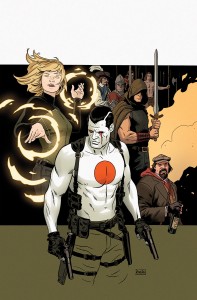
Simons: That’s a great question. I think that Armor Hunters will be a bit of a delineating point in the way that we, the universe operates with the giant aliens who basically have come down and attacked the earth. We have superheroes in our universe, so our response to what I have talked about with Matt and Josh with what the trajectory of the universe will be after that, I have seen a lot of it expanded with the Armor Hunters: Aftermath title that Rob is working on–Unity #12, #13, and #14 and another book with Josh that we haven’t announced yet.
Dysart: That and the world is in a really interesting place. It’s not just a mass scale invasion that happened right on the tail end of the outing of the pilot, so there’s this whole sub-group of human beings that have been manipulating markets and essentially controlling human affairs since World War II. It’s a bit of a shell shocked world–it’s not just the alien invasion, it’s not just out there anymore, it’s also in here. Everything has changed. So humanity is in a pretty frail interesting place.
Simons: How would our fictional Valiant Universe respond to something along these lines? The Valiant will be four issues, it will be in-continuity, and it will have a direct impact on the world after the story ends. It will have massive reparations for the universe.
Comics Beat: Is it safe to classify The Valiant as an event series?
Kindt: If it’s an event, it can only be classified as such because the scope is so big. It’s going to involve the entire Valiant Universe you know. So we are basically taking this small story as a mine cart that we are going to ride through the entire Valiant Universe and you are going to see everything–you are going to see it’s a great place to start if you have never read a Valiant book. You are not going to see the origin of every character, you are not going to know what Ninjak is all about; but you are going to see him, and you are going to be like that guy is awesome you know for like the little bit he is in, it’s a small story with a large scope
Simons: It will be accessible, it will be an entry point, but it will take a look at really the entire universe and wit will have bloodshot eternal warrior Armstrong, Kay, The Geomancer. They will come out of this changed for the most part.
Comics Beat: Because it is billed as a prestige format, do you think it could even last longer than the typical event if it has an era of nuance about it like something in the style of Kingdom Come?
Simons: Possibly, but we try to bill all our books like that to be honest with you. I hope Josh’s run on Harbinger is the defining run on Harbinger that’s on the shelf in 25 years. I hope the same thing about the first run of X-O or the first 12 issues of Unity. I really want all the books to feel special. We aren’t treating this one to feel more special. We want all the books to kind of have that feel that this will be the defining run. The scope of this along with Paolo’s extraordinary art that’s coming the pages just looks absolutely amazing. It will be something that will stand the test of time, but I am not walking into this project thinking that we are absolutely going to hit grand slam and that this will be on the shelves in 25 years’ time. I just want it to be as good as Unity, Harbinger, and X-O Manowar and that’s where we are starting at.
Kindt: There are so many superhero comics on the market. What’s the point of putting another in the one world if you aren’t trying to do something different with it? Like I love coming into this universe, and I can come up with a creative way to tell the story maybe you have seen something similar, but you’re not going to see it being told this way with comics. These are things that I have never seen comics do before you know, that’s just what I love most about comics instead of just panel panel panel panel story. It’s more about what makes you think of comics as a medium you know, as much as the story.
Simons: I feel like everyone is bringing their A-game and that everyone is putting their heart into it.
Comics Beat: Thanks!
Blog: PW -The Beat (Login to Add to MyJacketFlap)
JacketFlap tags: Comics, Image, Breaking News, Image Comics, SDCC '14, Add a tag
by Zachary Clemente
Sometimes, it’s the smaller details that stand out most. Sure, Image Comics is pushing for changes in the comics industry and has really been an a great example of how different publication platforms bolster the climate for making comics. Sure, they’re making new programs for retailers to make it easier to manage Image’s extensive line of new comics when shelf-space is at a premium. But the fact that they put together an all-artist panel composed of a 4:3 women-to-men participants speaks volumes.
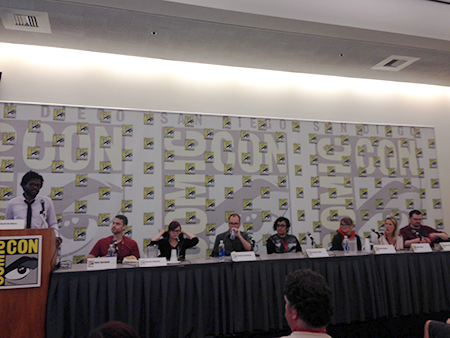 The features artists were Chris Burhman (Nameless), Becky Cloonan (Southern Cross), Gabriel Hardman (Invisible Republic), Sloane Leong (From Under Mountains), Amy Reeder (Rocket Girl), Tula Lotay (Supreme: Blue Rose), and Declan Shalvey (Injection).
The features artists were Chris Burhman (Nameless), Becky Cloonan (Southern Cross), Gabriel Hardman (Invisible Republic), Sloane Leong (From Under Mountains), Amy Reeder (Rocket Girl), Tula Lotay (Supreme: Blue Rose), and Declan Shalvey (Injection).
Image Comics’ David Brothers started off with some questions about process and approach.. Burnham, working on Nameless with previous collaborator Grant Morrison found himself being stretched as he develops a working method of “strange geometry” and “super tangents” where he makes bizarre choices in representing perspective on a page. Hardman, asked about his process of storytelling, enjoys utilizing the available poetry to the limited amount of panels he’s able to use.
Leong, collaborating with artist Marian Churchland (co-writing From Under Mountains with Claire Gibson) discussed the division of labor on the book. All of the internal art is her, while she and Churchland will work together on the covers. She then went on to touch on coloring in comics, a role she is often in.
Color depends on the art, too many comics have color because someone says “we need a color product.” – Sloane Leong
Reeder, when asked about her approach to coloring her own art on Rocket Girl, finds that her palette is very wide a single page can contain a wide variety. She draws from different influences when coloring the two time periods that are portrayed in the book, which create very different palettes.
Cloonan, who has previously self-publishers comics with her own writing and art, drawn for scripts will now be writing for Andy Belanger on their newly-announced Southern Cross. She went into the differences of roles, but ultimately iterated that it comes down to the sorts of challenges her working style will have to adapt to not being in charge of the visual narrative of the book. She will be doing all the covers however (which I am thrilled for) so it’s clear she and Belanger have a collaborative working relationship.
Burnham and Hardman, two of the most technically-minded artist I’ve heard talk, discussed the different approaches to leading the readers’ eyes along the narrative of the page in an intuitive way – even though they approach with vastly different techniques. Burnham bounces the eye with dynamic movement, often breaking borders and panels out into a more fluid visual, mimicking the cadence of the story, while Hardman typically uses a static page layout, moving the eye panel to panel instead of using crazy compositions.
The panel was then opened up to the Q&A from the audience. A couple of younger fans asked about how the Image platform functions and what sort of work best fits with the publisher and it seemed that all the panelists were excited to discuss the ins and outs of the company’s breadth of published work and how the submission and ownership process works. Brothers, moderating, summed it up best.
We work for the creators [...] we want to do what you want to do. – David Brothers
One of the most interesting questions for the panelists was one about using photo-reference. All of the panelists had different approaches to it, some seeing it as a stage in their process, others seeing it as a sometimes-useful tool; a couple reluctantly seeing as almost “cheating.” Many credited photo reference as extremely useful for figuring out how cloth would drape and hand motion is captured – finding that portraying credible subtle movement as something worth succeeded at even through photo reference. As the topic was bounced about, critiquing the use, Shalvey had a good take on the process.
There’s a difference between reference informing the drawing and reference dictating the drawing. – Declan Shalvey
In the end, the panelists essentially agreed that reference can be a supremely useful tool, but when too heavily depended on, you just end up drawing a photo, not a panel. Additionally, the point that the drawn characters need to be viewed as “actors” and basing them directly off of photo-realistic reference undercuts the credibility of the visual acting and artistic ability.
Lastly, an interesting question was their feeling on how people read their comics digitally, since many readers, such as ComiXology allow panel-by-panel reading. The resounded response was no – they don’t care at all. Most suggested that people are going to read they want to read and they just have to make the work speak best to all readers, digital or print.
Thanks for joining us for our Image Comics coverage! We’ll hopefully be right back at it in October for New York Comic-Con in October.
<3 – The Beat Staff.
Blog: PW -The Beat (Login to Add to MyJacketFlap)
JacketFlap tags: Conventions, Top News, Top Comics, SDCC '14, channel conflict, Add a tag
 It seems like every time SDCC rolls around, there’s a referendum on the state of comic conventions in the mainstream media and in the comics media. Sure enough, Comic Con ’14 rolls around and the same old song repeats. Let’s break the state of things down into the two components that get most of the dander up.
It seems like every time SDCC rolls around, there’s a referendum on the state of comic conventions in the mainstream media and in the comics media. Sure enough, Comic Con ’14 rolls around and the same old song repeats. Let’s break the state of things down into the two components that get most of the dander up.
#1: A consumer convention is different from a trade show.
This year it was the New York Times that issued an article that didn’t really have a clue that there are two different type of conventions. It’s always somebody. I don’t think enough of it to link to it, but I’ll link to one of the responses here at The Beat. Before I go over the differences between the two, let me drop some credentialing on you. I’ve produced interactive exhibits for trade show booths. In the medical industry. Where they think nothing of spending $250K-$500K on trade show booth materials and staffing. Oh, they’ll use the booth and elements of the booth at multiple shows, but that’s there to illustrate the vast difference in budgets involved (although the TV and movie folks spend a bit more on their marketing than the publishers).
Convention centers usually have a little bit of government oversight. Not always, but usually. They’ll be partially funded with an eye on “economic impact.” How is this measured? Hotels around the convention center, bars and restaurants around the convention center. Taxis. Car rentals. Bonus points for things that can have a tourist tax on them. As I understand it, part of the problem with WonderCon and San Francisco is that the “economic impact” doesn’t hold a candle to a medical show or a tech show. Hold that thought, we’ll come back to it.
With a trade show, most people are staying in the hotels near the convention center or in a designated corridor of business class hotels. There will be all kinds of after hours activities. Multiple restaurants/bars/clubs rented out for the evening with open bar. 20-50 person steak dinners for extended sales pitches. Most of those people not getting their meal bought for them will have a decent expense account and go to the GOOD (read: expensive) restaurants either around the convention center or in that business class hotel district.
SDCC is unusual in that it does have tradeshow levels of private events. I’m not sure if the head count invited to those private events is the same (and the venue gets paid by head count), but they have them. It completely misses out on the expensive meals, though. That said, I’ve often wondered if the inflated hotel prices have really been taken into account in the SDCC economic impact studies.
Now, if we step away from SDCC and just talk about conventions in general. A regional convention, where the bulk of attendees aren’t staying overnight, loses out on all of the above. Maybe a slight a hotel room bump and some casual dining dollars. A national show – one where you have a lot of attendees flying in – is going to get a hotel bump (but possibly more action for the tourist hotels, which may not be valued as much) and a casual dining bump, but not the big dining dollars.
The per attendee dollars spend in the community can’t touch a trade show. Period. If the show is big enough, it can even out, but consumer shows are more of a “fill in the open dates” scheduling item in the greater scheme of things.
Don’t kid yourself, though. SDCC is big enough, Anaheim and Las Vegas were drooling over getting that kind of attendence in town. Nothing wrong with full planes, hotels and taxis.
Wonder Con, though, that’s another story. No steak dinners. Barcon might not be at a hotel bar. You’ll have more people staying in different neighborhoods. Lots of locals. It’s just not going to track. Should there be a Wonder Con in SF? Absolutely. Do they have a fight with Moscone over economic impact? Yeah, that’s probably legit from an oversight perspective. It would be nice if the tech industry leaned on some politicians for that. Locals can be served too, not just out of towners.
#2 The new <insert here> is ruining conventions
Comic conventions, by and large, are pop culture conventions. There, I said it. There have always been celebrity autographs at all the shows I’ve ever been at. I remember the Chicago Comicon, under the original management, would have huge crowds for the Babylon 5 and Kevin Smith panels. I was even part of that with a “Mystery Babylon Theater 5000″ panel (before the pirated the idea at SDCC, thank you very much). This is not a new thing, so much as it’s been more fully integrated. It’s also part of conventions opening up to a wider audience. Sorry, the audience is less focused than it used to be and commerce patterns have changed.
The person shouting the loudest about the changes this year seemed to be Chuck Rozanski of Mile High, who’s gotten a lot of PR by declaring he wasn’t bringing his retail booth(s) back to SDCC. Rozanski is taking the position that he’s lost too much business to the publishers selling convention exclusives at their own booth. He’s not the only one making complaints. I’ve seen some complaints on the social channels that cosplayers are taking up space that could be occupied by comics fans who might buy something.
These are old trends that get brought up every year like they’re new things. One of the consequences of comic shows being more of a pop culture convention is that you have a wider demographic. Wizard World Chicago morphed into an autograph show where pretty much all the comics activities were in Artist’s Alley. Some cosplayers come to convention for the comics and just enjoy dressing up. Some come for the anime or movies and like dressing up. And yes, some of the cosplayers are just there to dress up. So what? I know people who like to wear bow ties, too. There’s also a growing trend of conventions as primarily a social experience. You go to meet friends you see at conventions and to meet new people with common interests. This seems particularly big on the anime side of the aisle.
There’s also been a looooooong developing story on the changing face of commerce at conventions. It seems like the comics portion of shows is moving towards the direction of high end/rare back issues and hot books or deep discounts. And perhaps a slice of “things to get signed by convention guests.” Back issues are now something of an online shopping item. And Rozanski ought to know about that.
To be honest, the Chicago shows – particularly Wizard – turned into such a deep discount flea market at one point that I started getting an attitude about paying $5 for tpbs. I mean, a couple places were selling them for $4. That’s the nature of the beast and I expect you really can’t pull that off at a national show. (And we all have a friend who only goes to a convention the last day of the show to see what kind of fire sale prices he can get, right?)
With the more diverse crowd, you have increased opportunities to sell stuffed animals, t-shirts and novelties to people who aren’t there strictly for comics. Nothing wrong with that, either.
Ever notice that nobody complains that the bootleg video booths aren’t nearly as prevalent as they used to be?
Is the complaint about the publisher booth having exclusives and diverting dolloars valid? That’s a complicated question.
- Are attendees spending money there instead of at retailer booths?
- Are the exclusive item lines so long attendees don’t have time for retail shopping?
- Since it’s not weird somebody would buy a convention exclusive instead of a back issue they could order online, is this an argument about who should be the one selling the convention exclusive? (Comics should be the textbook case study of “channel conflict.”)
- Are the consumers spending more time in Artist’s Alley instead?
Yes, Artist’s Alley and the retail section are in conflict. If I’m buying something and the person is in Artist’s Alley, unless the retailer has a pretty big discount, I’m buying it from the artist every time. Supporting the artist directly is a full-on trend these days. See Kickstarter. See Patreon.
Do the publisher’s exclusives detract from Artist’s Alley sales? I’m not sure. I know a few people who swear by shows like Wizards put on because they don’t have much by way of publisher’s booths, so the comics fans at the show can go straight back to Artist’s Alley. Sometimes they mention not having to compete with the exclusives, more often just that Artist’s Alley is where the comics part of the show is at.
As these conventions get bigger, more vendors want to get in and the price for the booths keeps going up.
But you know what else is absolutely true? The booth prices are getting more expensive for the publishers, too. And comics is not exactly a high margin business.
The demographics of the attendees are getting broader. Exhibition costs are going up. Buying patterns are changing. Direct to consumer sales anger is flaring up again. Alas, very few things in this world stay exactly the same. This seems like a few different heads all coming to a head and it’s been a few years in the making. Whether this extends down to the next layer of conventions – your NYCC, Emerald City and Wonder Con — remains to be seen.
Blog: PW -The Beat (Login to Add to MyJacketFlap)
JacketFlap tags: Legal Matters, Conventions, Fashion, Top News, The Legal View, SDCC '14, Add a tag
 Comic-Con hit TMZ after America’s Next Top Model winner and media personality Adrianne Curry, dressed as Catwoman, chased down and whip-punched a man who thrust his hands down the tights of another model dressed as Tigra. As horrible as Sunday’s attack was, could this incident help us deal with such harassment more effectively?
Comic-Con hit TMZ after America’s Next Top Model winner and media personality Adrianne Curry, dressed as Catwoman, chased down and whip-punched a man who thrust his hands down the tights of another model dressed as Tigra. As horrible as Sunday’s attack was, could this incident help us deal with such harassment more effectively?
Curry’s superheroic response to the sexual attack on her friend Alicia Marie underscores the importance of taking sexual harassment at comic conventions seriously. Comic conventions have experienced exponential growth in recent years, filling not only convention venues but downtown city streets into volatile vectors for sexually inappropriate behavior. And contrary to the stereotype-ridden TMZ video, dorky fanboys are not necessarily the only culprits – downtown San Diego has become a five-day Festival, with the Red Hour striking anew each time you walk out the Convention Center doors.
How to deal with the problem of harassment within and without Comic-Con was attracting the attention of multiple media outlets even before the attack on Alicia Marie — in fact, after I scheduled this post for publication on The Beat, even Perez Hilton found the Adrianne Curry incident to be a source of moral outrage. Over the next couple posts I want to add a legal perspective, since this happens to be an area in which I have clocked a few villains of my own, albeit with words instead of a whip.
Before we do, however, I want to address a thought that may have popped into the minds of some readers, namely, the notion that women such as Currie and Alicia Marie are themselves somehow asking for it. I actually witnessed a vivid expression of this mindset when a cosplaying woman outside the Con tried to fend off a guy’s come-on by handing him a business card and promoting her own work. The guy responded by contending that there was no other way for a man to take the way she dressed than as a sign that she was looking to get laid.
This exchange stood in stark contrast to the professional discussion I’d just had with a longtime of the annual Comic-Con Masquerade, the amazing Broadway actress and theme-park entertainment designer Diane Duncan. Last Friday when we were walking through the convention chatting about cosplay she stopped to point out what she thought was a standout example of excellent craft, a woman dressed as Poison Ivy whose costume exhibited a number of characteristics that would have done well for her had she worn it for the Masquerade competition instead. The costume had a sensual vibe, yes, but that was an extension of the workmanship — whether the cosplayer’s aim in such artful attention to detail was self-expression, marketing a product, promoting her own business or a combination of all three, baiting men for sex was not the point.
As it turns out, the cosplayer was none other than Adrianne Curry, and as I read up on her and other models who cosplay I found myself in rather familiar territory. In advising on ethics and other legal matters in the fashion industry, it’s all too common to run across men who view what women wear as a sign of sexual availability, as opposed to a form of stylized expression that for many women in modeling, marketing, retail and design is an integral part of their professional identity.
The intrinsic connection between cosplay and fashion got me thinking about another connection they share: namely, unfortunate loopholes in current sexual harassment law. Although we often use the phrase “sexual harassment” when speaking of unwanted advances to cosplayers and fashion models alike, from a legal perspective the term typically refers to sexually inappropriate behavior in certain employment contexts. For example, because models are typically independent contractors, not employees, they are often not protected by sexual harassment laws, and a similar principle applies to comic convention cosplayers who are not there in the course of employment — regardless of how egregiously inappropriate the behavior may be, it technically is not a violation of sexual harassment law, nor would it fall under the purview of a typical harassment policy.
Within the fashion industry, this lacuna is being addressed primarily in two ways: through legal reform and private action. New York, for example, recently enacted a law that extends the protections in child labor laws to underage models, and efforts are ongoing to give volunteers and independent contractors new legal protections when sexually harassed. At the same time, the campaign against harassment within the industry is giving rise to new standards and practices that go beyond the limits of sexual harassment law while taking advantage of more general protections that other laws already provide.
We’re seeing a similar strategy evolve among cosplayers in regard to private action, most prominently in the work of Geeks for Consent, whose signs could be found throughout the convention center this year. I was glad to meet the group’s intrepid director, Rochelle Keyhan, briefly during Comic-Con, and have considerable regard for its efforts to call attention to this important issue. However, it’s also clear that a sharp divide persists between those calling for a more rigorous sexual harassment policy and Comic-Con itself, which has taken the position that a sufficient policy already exists. Awareness, as they say, has been raised, but the ideal provisions of a convention harassment policy remain a matter of dispute.
In my next post, we’ll take a deeper look at the Geeks for Consent campaign, the Adrianne Curry incident and existing law to see whether we can devise a new policy that will address the concerns of all sides in the ongoing debate. Meanwhile, if you have any opinions or experiences pertinent to this important discussion, please feel to leave them in the comments thread or shoot me an email at [email protected].
Blog: PW -The Beat (Login to Add to MyJacketFlap)
JacketFlap tags: Covers, Art, Top News, SDCC '14, Add a tag
By Matthew Jent
Oh, gang. What a fun panel.
Moderated by legend-in-his-own-time Mark Evanier, “Cover Story: The Art of the Cover” took five artists, gave them five of their own covers apiece, and had them talk about them. The covers had been chosen ahead of time, without the artists’ knowledge, and Mark hoped at least one of the choices would be a cover the artist didn’t like.
“Even if we take some potshots at your covers — it’s coming from a place of affection. Even Rembrandt had a worst painting.”
We’d be here foreverlong if we went cover-by-cover, so let’s just hit some highlights.
“Jack Kirby hated doing covers,” Mark explained. “He never knew when to do them. Before the comic, he didn’t know what the most exciting scene would be. During the comic, he didn’t want to interrupt his flow. When he was done, he wasn’t emotionally invested in that issue anymore.”
“I agree with Jack,” Amanda said. “I prefer sequential storytelling. I like Norman Rockwell — when you can look at a piece of art and tell lots of things are going on in it.”
“Okay — this was before I got into storytelling. Boy, they made me make her way too skinny.”
“Y’know — geez, lookit her boobs! I wanted to pull a moment of time out to focus on the cover, a moment that happens in between panels. So you don’t see this in the book, but it still moves the story along. Paul Mounts colored it — I put the stars in the background, but he did the burst. If I trust him and leave the background blank, he goes in and does a nice design.”
This cover gave Mark the opportunity to tell a Wally Wood/Power Girl anecdote, with Amanda’s encouragement: “Wally said, ‘I’m going to make her boobs larger every issue until somebody stops me. I think they just took him off the book instead.”
“Okay, I don’t always do big boobs, guys. This is another example of moments in time you don’t see often. Zatanna lives in San Francisco now, and I wondered, what does she do every morning, before she goes to fight things that want to destroy the universe? Probably the same things I do: get a cup of coffee, and a muffin, and read her iPad. Except, on the Golden Gate Bridge. My favorite thing is showing well-known superheroes doing an everyday thing that you and I do.”
“Last night were the Eisner Awards, aka the Fiona Staples Show,” said Mark, by way of introduction. “The best thing about the Eisners is that whoop from the audience when they agree, yeah, that’s the one that deserves it.”
“This was my first issue of my first comic. It was an oil painting, before I did everything digitally. They cropped it, but — that would have been my call. It’s an awkward place to cut off the image, at a joint, at the neck.”
“For Saga, the cover is part of the entire package. We don’t give away much story on our Saga covers. I usually do the cover before he scripts it — Brian told me, put Lying Cat on this one and make it dark. I had a feeling something bad was going to happen, so I gave Lying Cat a bloody mouth, like she’d taken a bite out of one of our heroes.”
“For the last few years, I’ve been pretty exclusively a cover artist. It’s not really storytelling — I’m trying to sell the book. The cover has to be done the month before Previews hits — if we’re lucky, we have a short paragraph of what happens on the inside. The beauty of designing a character as a cover artist — I don’t have to worry about the interior artist who has to draw every angle of that character for 22 pages.”
“My first for Marvel, ten years ago. It was introducing a new Spider-Girl. I really stunk at foreshortening, so her leg looks really weird. Joe Quesada designed the character, but I put in the pouches around her wrist — I still don’t know what purpose they would serve.” (An audience member shouts out — chaptstick!)
“One of the few times Cable got one up on Deadpool. But to keep them in frame, I had to have him hold the gun by the trigger and almost let it fall down, over Deadpool’s head. To this day, I think it looks very weird.”
Mark Evanier chimed in that, in earlier days, Marvel would have rejected this one because the figures obscured the title.
“That’s different now,” Brooks said. “I can pretty much cover up the entire title, as long as it’s with the main character of the book.”
“In the original solicit, Deadpool was dressed like Jimi Hendrix. Marvel found out Hendrix’s estate is very litigious. I had to go in and take out the striped shirt, take off the wig, and flip it so he wasn’t playing left-handed.”
Jae Lee.
“I always think I enjoy covers, but I always regret doing them. I’m not a fan of showing these out of sequence, because I’m afraid the same re-used images are going to crop up. I won’t have a lot to say about these because they were all done in a mad rush to get into the solicitations.”
“This was done for solicitation. It was an Ozymandias book, but the cover features the Comedian. Where this fight was happening, they were surrounded by falling action figures. I hadn’t finished it, so I cropped it and said, is this good enough for now? I said I would come back and finish it later. But I never finished it.”
“This was tough. It’s my second time drawing a car. I’ve been doing this 22 years and managed never to draw a car. I don’t know how to draw cars, so it has to be mangled. I don’t know how artists draw those things. The tires — I don’t know how you guys do it.”
“Also, Power Girl was much bigger than Superman, so we had to reduce her digitally. But then her head looked too big, so we had to reduce he head separately. It became a kind of Frankenstein project. I have a hard time looking at it.”
Amanda chimed in by saying she has no problem with cars, but hates drawing mangled wreckage.
“Oh, we should trade off,” Jae said.
“I hate doing covers. I hate it with a passion. I have been doing covers with the same character for the past 30 years, so it’s difficult to think of a different situation for that character. The covers are done months ahead of time, and my writer, who is me, often has no idea what is going to happen in the interiors.”
“This was a commission — a guy commissioned me to do a kite festival. So it was four connected pages. We used it for two consecutive covers. The colorist is Tom Bluth, who is my colorist of choice. In Tom’s case, it’s always — do what you want, Tom. I give him very little direction. I’m surprised sometimes by his choices, but it’s always better than I would color things.”
“Strictly a job for the money.”
“That’s funny,” Evanier added, “I worked for Eclipse — I don’t remember there being any money.”
“In Usagi, there’s always a little skull when somebody dies, and a guy always writes in saying how many skulls I had in that issue. So for this cover I drew as many skulls as I could. But then the guy didn’t write in, and I was disappointed. There was no logo, but Usagi is iconic now — when people see Usagi, they know it’s a Usagi cover.”
“Aw, I hate working for Disney. They kept saying ‘do it on model,’ but they didn’t give me any models! I must have drawn this duck’s head 7 times. The problem was, I was following the European design, which I prefer, and it’s a little different there.”
Evanier closed the panel by thanking everyone for participating, and saying he hoped panels like these remind folks that there’s always a story and a person behind the design choices of covers.
“These panels remind people — someone actually designed that. It gives people an appreciation for the art of the cover.”
Blog: PW -The Beat (Login to Add to MyJacketFlap)
JacketFlap tags: Top News, Kids Read Comics, SDCC '14, Add a tag
By Matthew Jent
This Sunday morning panel was moderated by David Mariotte of San Diego’s own Mysterious Galaxy, a bookstore that specializes in “Martians, Murder, Magic & Mayhem.”
“Middle Grade Extravaganza” focused on the books and series for a pre-Young Adult audience, and the panelists were a mix of prose authors and graphic novelists, including Rachel Renee Russell, New York Times-bestselling author of the Dork Diaries series; EJ Altbacker, author of the Shark Wars series; “that scoundrel” Brandon Mull, author of the Fablehaven series (whose greatest regret is that he has “but one life to give for Gondor”); Paul Pope, author/illustrator of the Eisner award-winning Battling Boy; P. Craig Russell, illustrator of the graphic novel adaptation of Neil Gaiman’s Graveyard Book, as well as a number of comics adaptations of timeless operas; the “ever mysterious” and sunglasses-clad Pseudonymous Bosch, author of the Secret Series and the upcoming Bad Magic; and Mr. 50-million-copies-and-counting Dav Pilkey, creator of Captain Underpants and Ricky Ricotta’s Mighty Robot.
While it wasn’t a packed room, it was impossible to squeeze into the front rows — the fans here for this panel wanted to make sure they had a seat close to the authors.
David led off the panel by asking, “What is it about series that works so well with middle-grade readers?”
Paul Pope responded by paraphrasing Scott McCloud’s Understanding Comics assertion that the space between panels allows readers’ imaginations to fill in the gaps, allowing for a richer experience. “Episodic fiction does something similar,” he said. “You get to fill in the gaps yourself. And it’s a tradition — even the Iliad was told in episodes. ‘Come back tomorrow night, at the campire.’”
Many of the panelists said it went back to their own experiences as middle grade-age readers and wanting to spend more time with favorite characters. “I wanted to read more about Harriet the Spy,” said Rachel Renee Russell. “You want to stay with those characters.”
Asked how they keep their stories accessible for tween-age readers, Brandon Mull said it comes down to writing good scenes. “I create a chain of good scenes,” he said, with “a main characters you can relate to. But a good story is a good story.”
During the audience Q&A, a young fan asked Paul Pope how he came up with the idea for Battling Boy. Pope said he wanted to make comics for an underserved audience. “I have nephews who were your age,” he said, “and they thought it was cool I was making comics, but they can’t see most of it. It’s geared toward adults. And I’ve done work for Adventure Time or Disney, but — when I was young, I read old Fantastic Fours or X-Men, but there just aren’t that many comic books now written for people of your age group. I wanted to write the best superhero for people your age, so they don’t have to keep going back to Batman, who is 75 years old, and Spider-Man, who is middle-aged.”
Another young fan asked Dav Pilkey if he’d had a mean principal himself when he was young, and if that helped inspire his book.
“My teachers and principals were very abusive, sometimes physically,” Pilkey said. “It did not help me. I remember telling me mother — not about the physical abuse, but the emotional, psychological abuse — and my mother told me, everything happens for a reason. Maybe something good will come out of this. I don’t think she had this in mind.”
Pope added that “One of the joys have writing to a young audience is, you retain your innocence. I’m writing to myself as a younger person in a lot of way.”
Pseudonymous Bosch, who wore sunglasses throughout the panel, added that, “It helps if your own maturity level stays where it was when you were 12.” He then took an “unselfie” of the audience, asking them all to cover their faces as he took their picture.
Rachel said that her Dork Diaries were inspired by her own children, who had struggled socially as kids, but who had grown into successful artists in their own right. She introduced her daughter Nicky in the audience, and who had taken over the illustrations for the Dork Diaries with the second book.
The Q&A unfortunately ended while there was still a line of young fans waiting to talk to the authors, but the panel headed off for a group signing that would hopefully allow for some one-on-one interaction. There’s often talk around the comics industry about whether comics have left younger fans behind, but at this panel it was clear that kids were still excited about comics and illustrated prose.
The key is — as it has always been — respecting the intelligence and imaginations of your audience, regardless of their age, and creating art that raises interesting questions.
“A hundred years ago, a good sci-fi writer might image we’ll have cars,” Brandon said. “But a great sci-fi writer will imagine we’ll have traffic jams.”
Blog: PW -The Beat (Login to Add to MyJacketFlap)
JacketFlap tags: Top News, more to come podcast, SDCC '14, Chuck Palahnuik, fight club 2, Interview, Interviews, Comics, Podcasts, Dark Horse, SDCC, Add a tag
 Live from San Diego Comic Con, it’s More To Come! Publishers Weekly’s podcast of comics news, interviews and discussion with Calvin Reid, Kate Fitzsimons and The Beat’s own Heidi MacDonald.
Live from San Diego Comic Con, it’s More To Come! Publishers Weekly’s podcast of comics news, interviews and discussion with Calvin Reid, Kate Fitzsimons and The Beat’s own Heidi MacDonald.
In part five of More To Come’s San Diego Comic-Con special podcast, Calvin Reid interviews award-winning author Chuck Palahnuik about his decision to write the sequel to his hit ‘Fight Club’ in comic book form, and the comics professionals who helped it happen. This has been San Diego Comic-Con 2014 from Publishers Weekly’s More To Come!
Download this episode direct here and catch up with our previous podcasts on the Publishers Weekly website, or subscribe to More To Come on iTunes
View Next 25 Posts



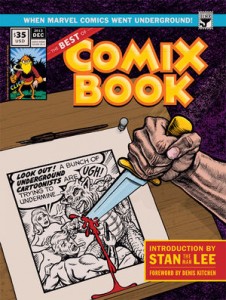
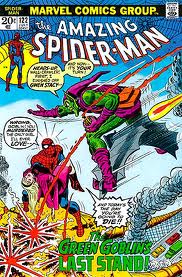
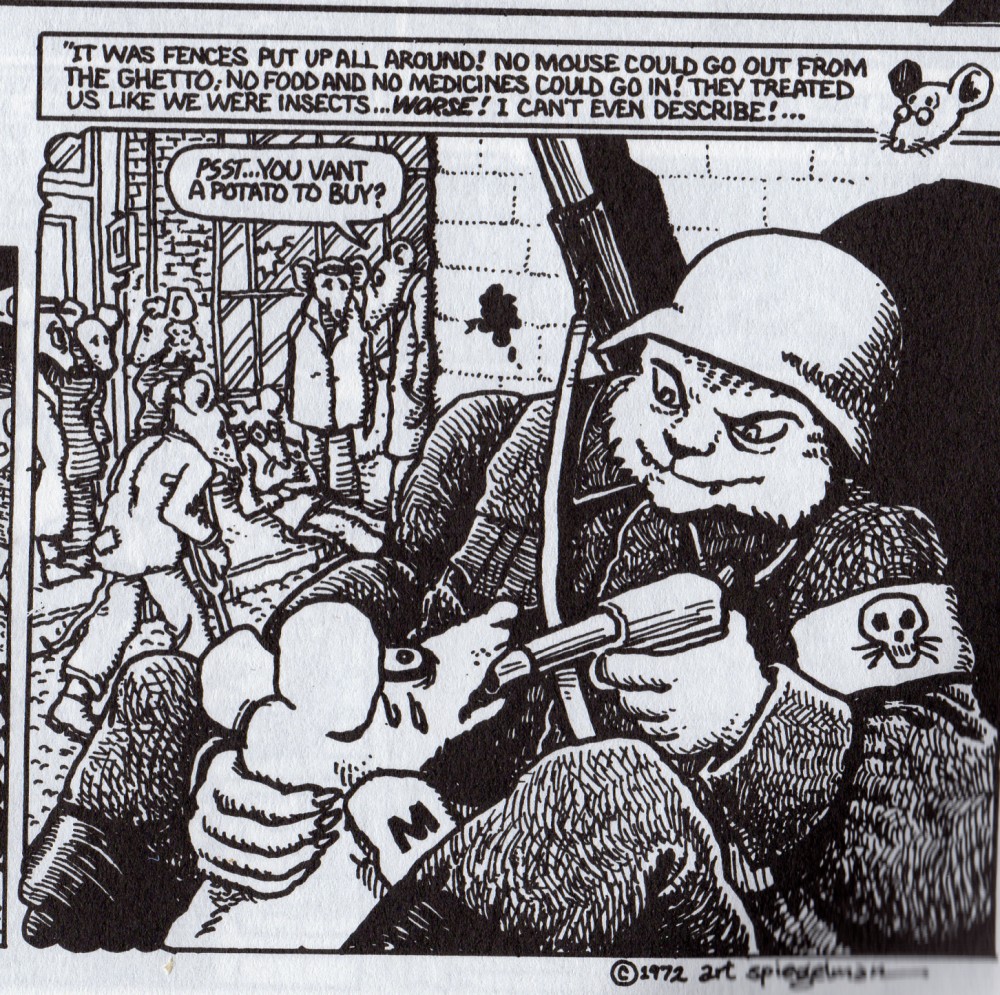

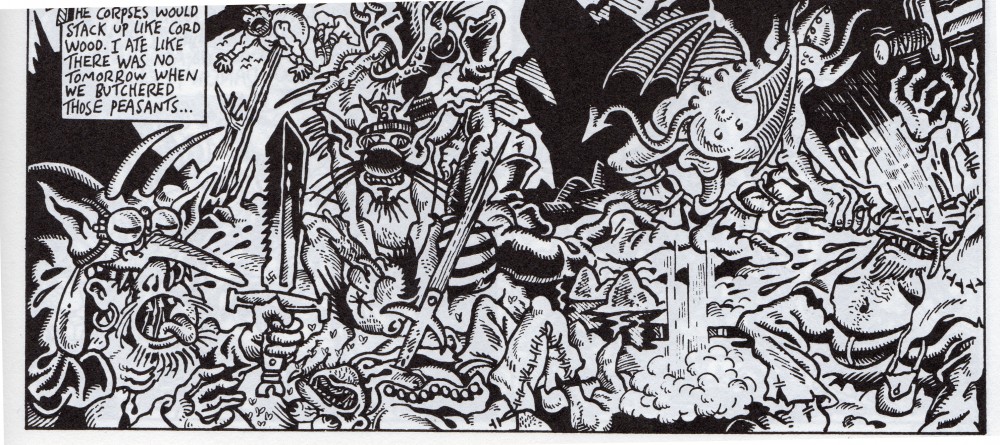














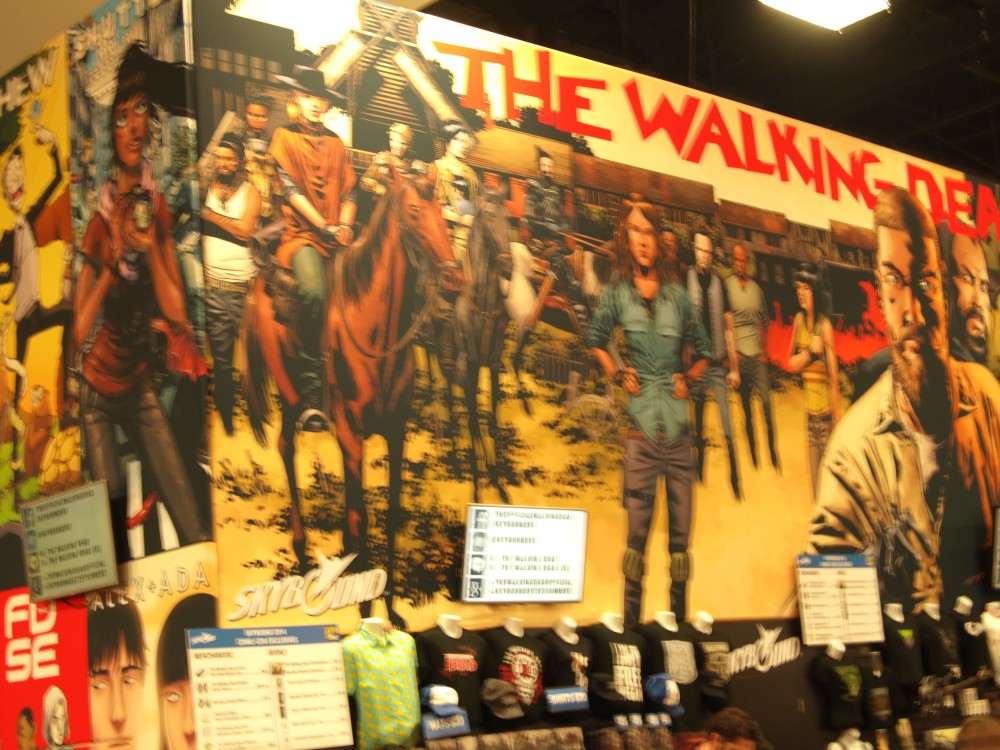


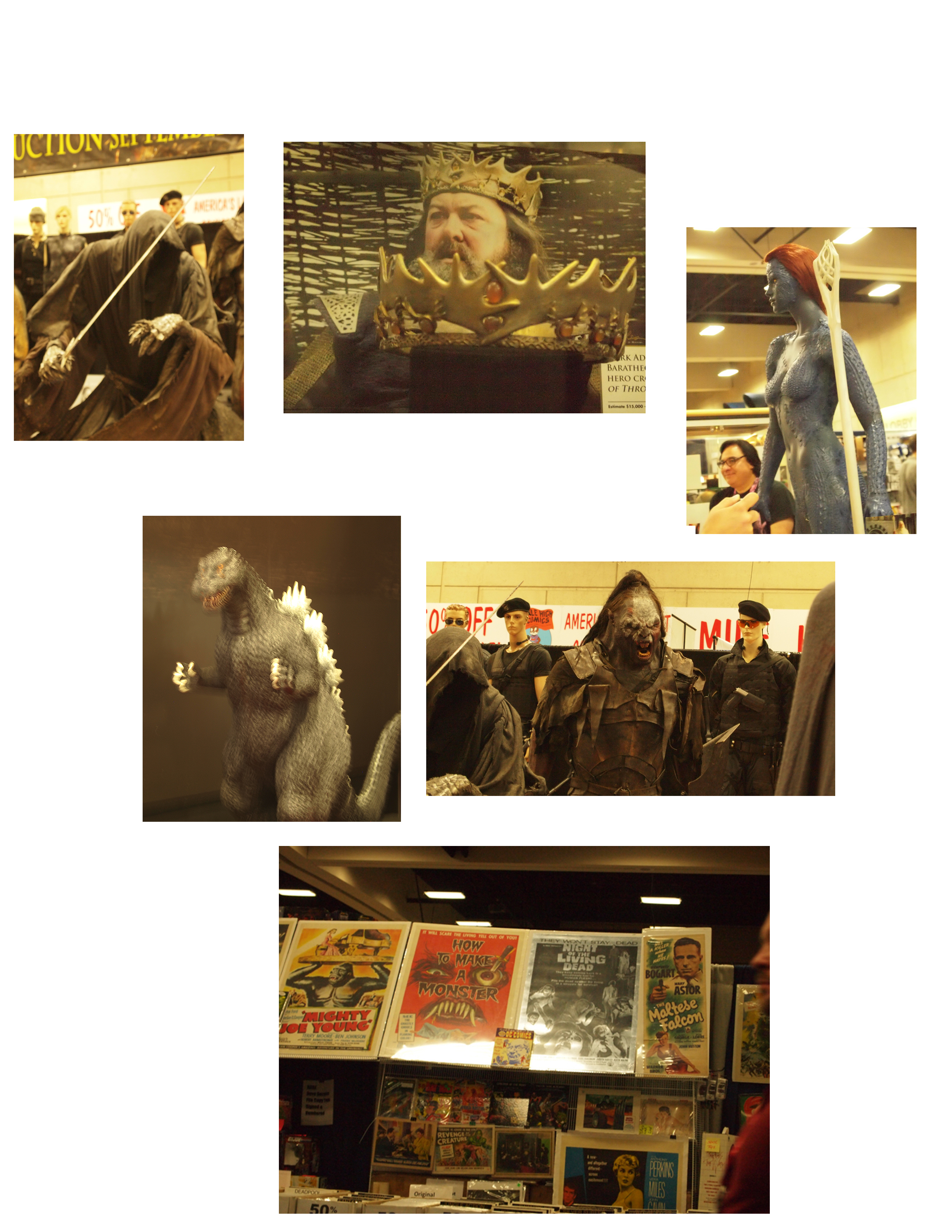



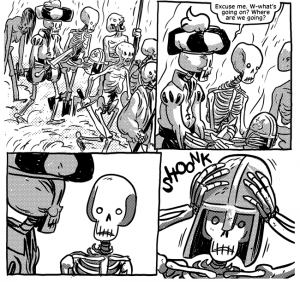

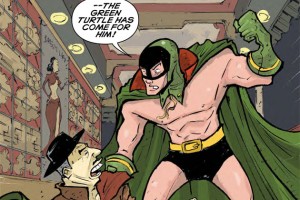
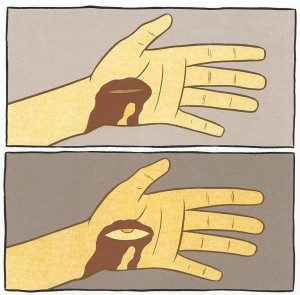
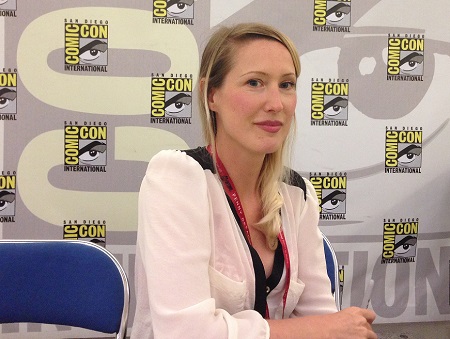

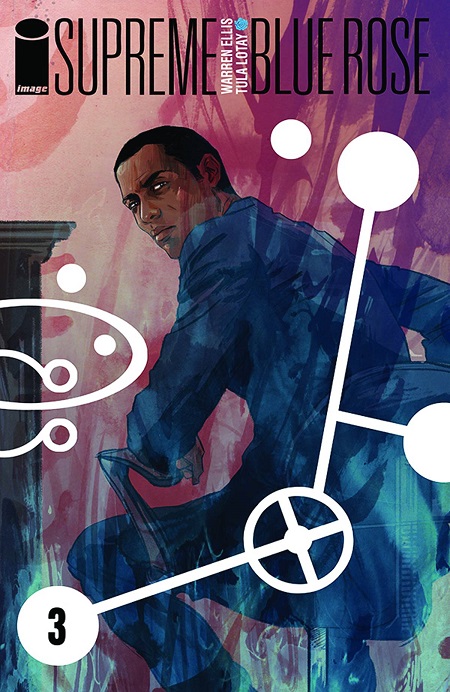

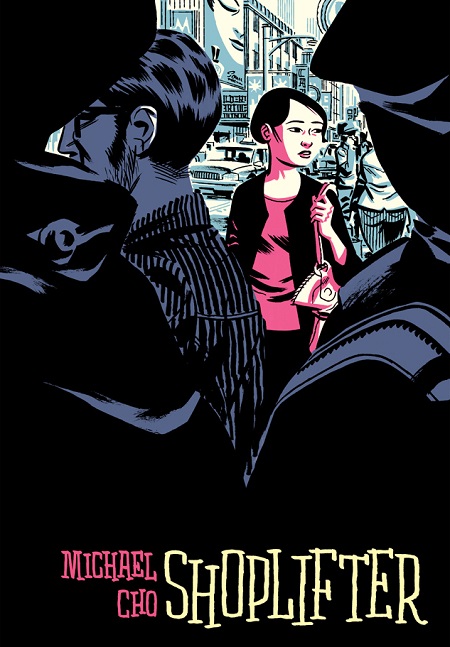
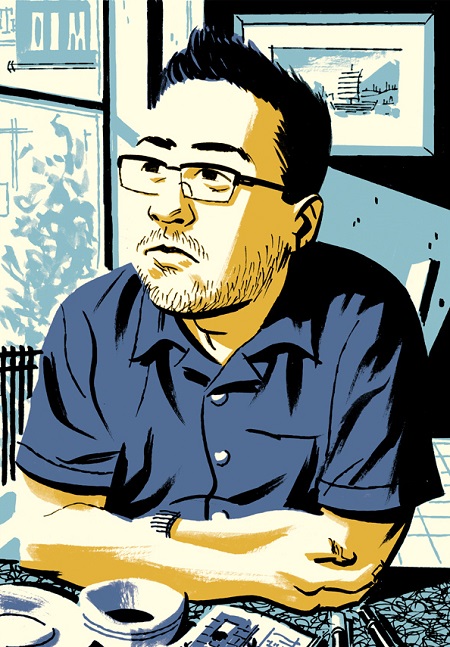

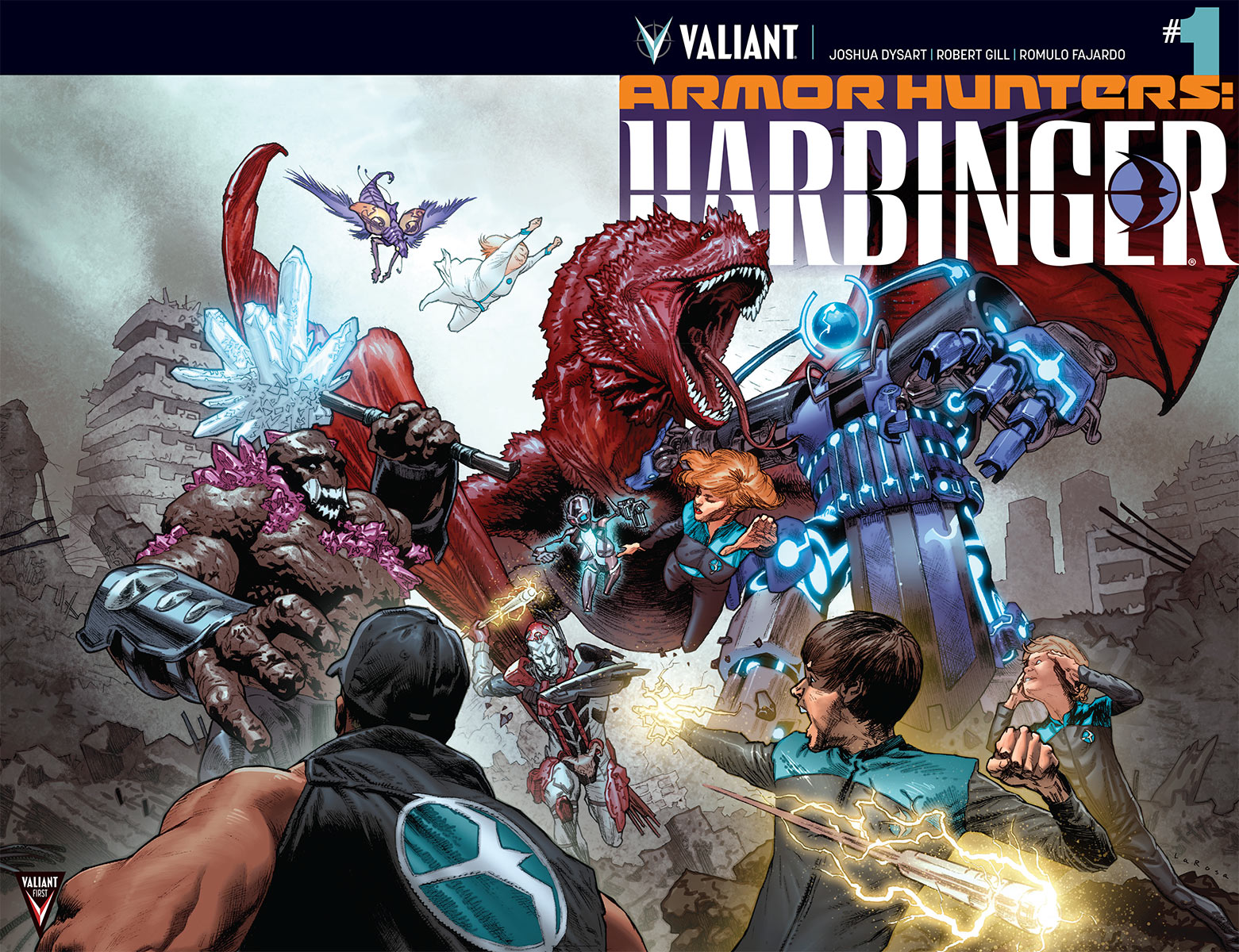

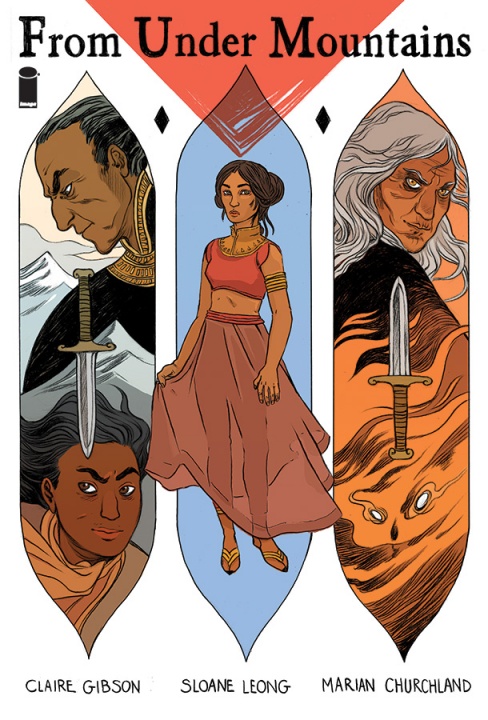
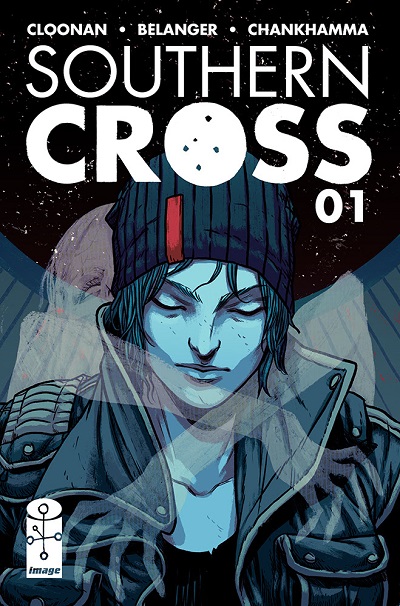

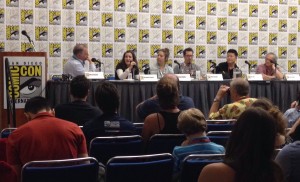
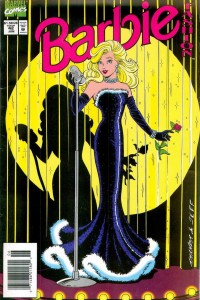
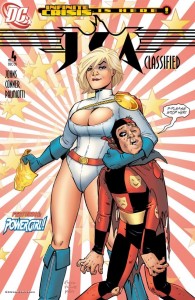



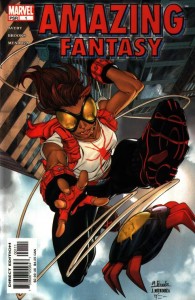
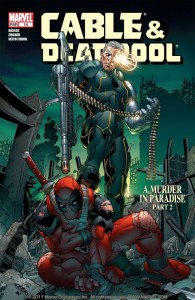
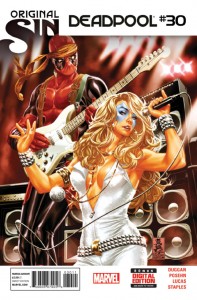
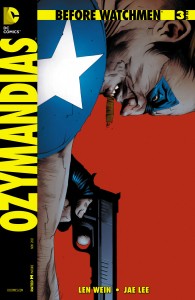
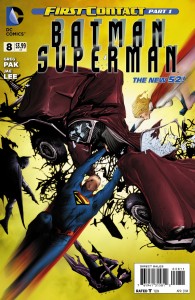
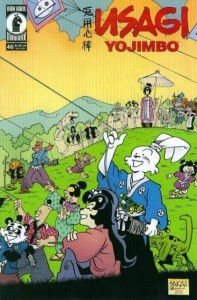
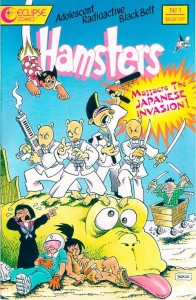

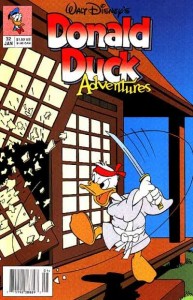

Wow- what a great piece of history! Can’t wait to get it.
I managed to complete the collection a few years ago.
After you read this, pick up the Witzend collection from Fantagraphics.
The 70s produced some interesting alternatives.
Everything from Warren down to stuff like Witzend and The First Kingdom.